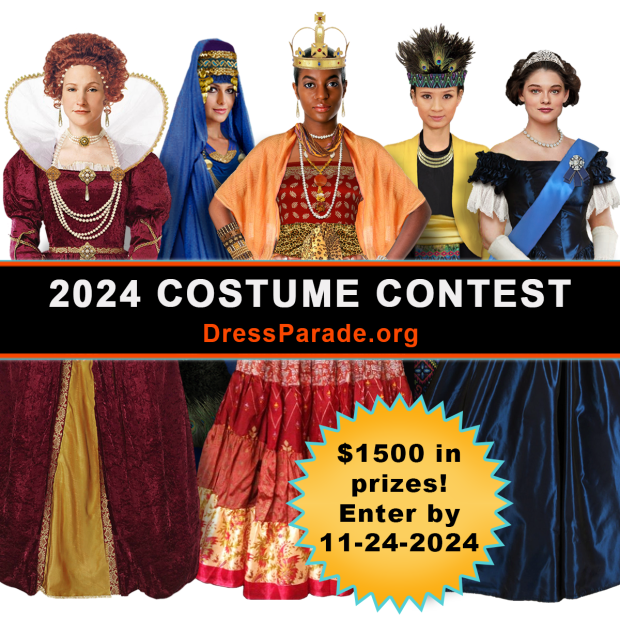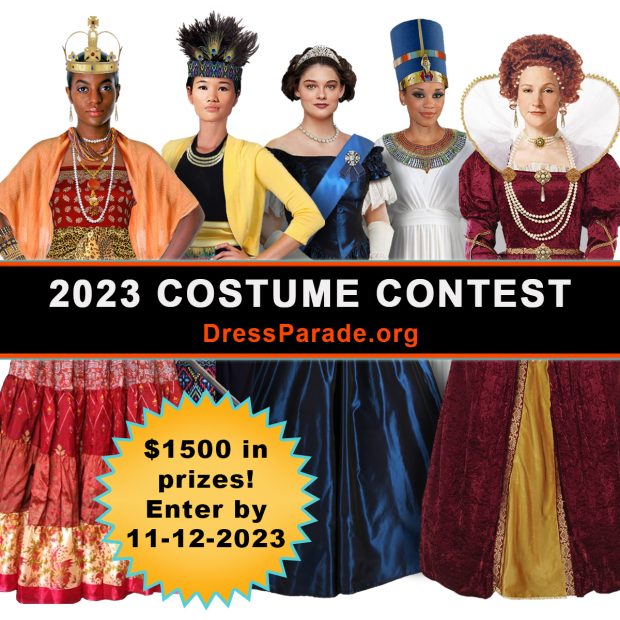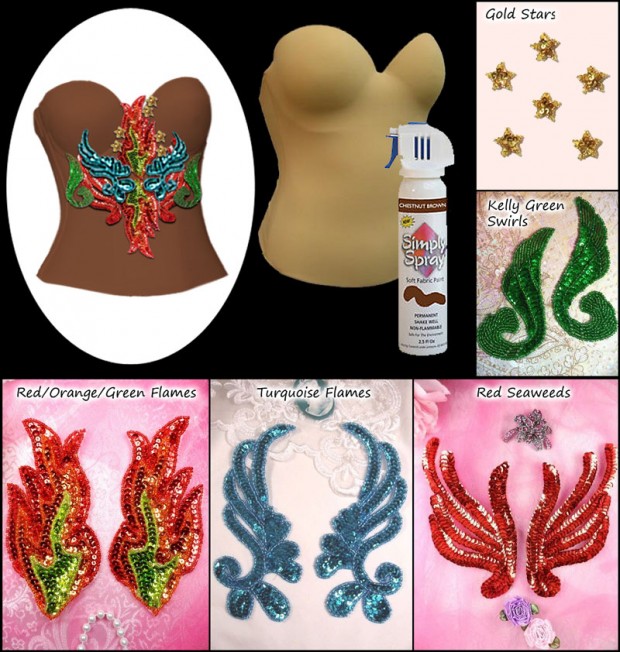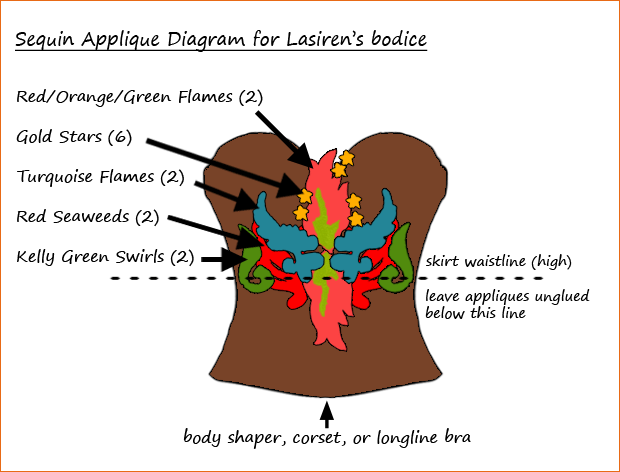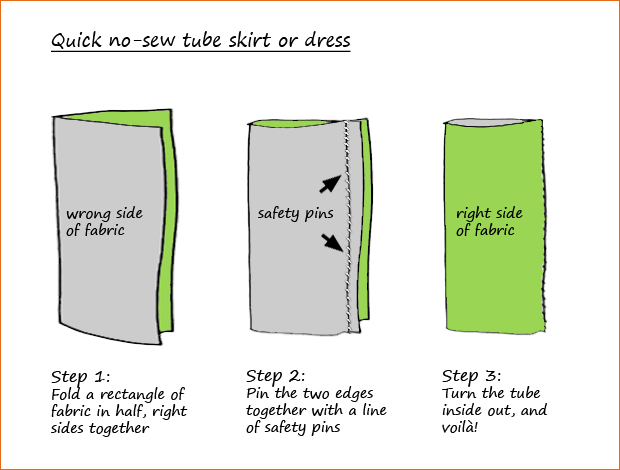Prizes are here! Thank you, everyone, for participating in our contest this year. It’s always a joy to see and share your inspiring, heartfelt creativity. Especially now in these very difficult times. Our community lives on!
I will be emailing the winners their Amazon gift certificates over the next couple of days. (For reference, here’s the original contest announcement.) All the winners have been posted on our Facebook page and uploaded to our 2025 Costume Contest Winners album. You can also review all the entries this year in our 2025 Costume Contest Album.
Okay, prizes!
Division I: Women’s History
These are the prize categories that we award every year. They’re based on our own costume categories here on the website: queens, goddesses and mythological figures, and notable historical women.
Best Queen Costume
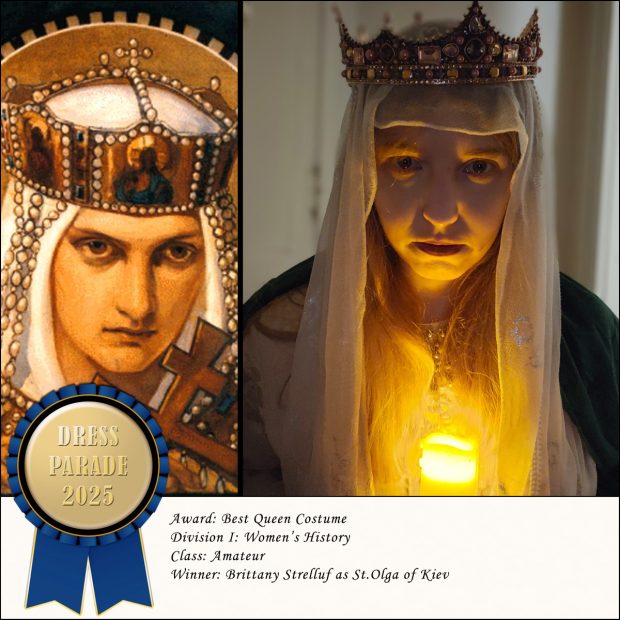
Winner, amateur class: Brittany Strelluf as St. Olga of Kiev.
Olga is one of my favorite saints; she was such a freak. Burning people alive! For reference, I included Nikolai Bruni’s famous illustration of Olga, which is exactly what popped into my head when Brittany’s entry came in. Brava!

Winner, hobbyist class: Janice Strickland as Empress Theodora.
Our costume page for Theodora suggests using readymade store-bought items to rig up a Byzantine look; Janice went with that concept but took it to the next level. She sewed that beautiful dalmatica herself, customized the collar and crown, added pearls and gold trim everywhere, and just generally made it fabulous. Wonderful work.
Best Mythological Costume
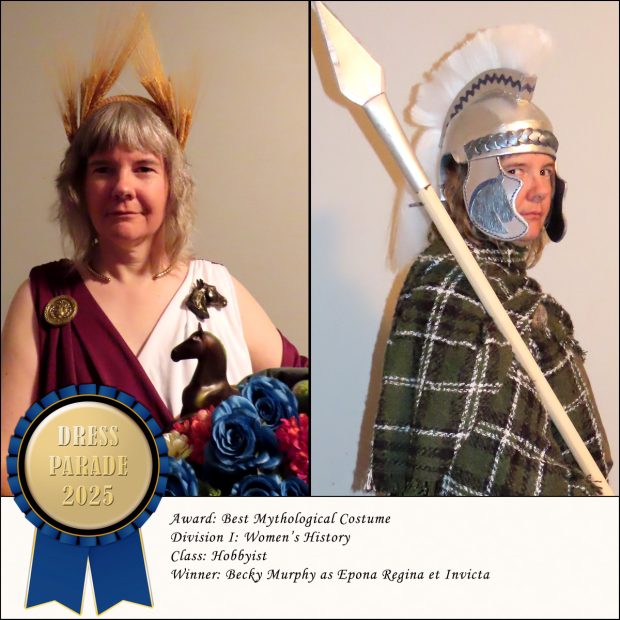
Winner, hobbyist class: Becky Murphy as Epona Regina et Invicta.
Becky really went all out for her Epona entry, costuming herself as both aspects of the goddess. The helmet for Epona Invicta is an especially impressive piece of craft-fu: Becky created the helm from high-density EVA foam, while her mother crafted the plume from white festival braids. Good job, Becky and Becky’s Mom!
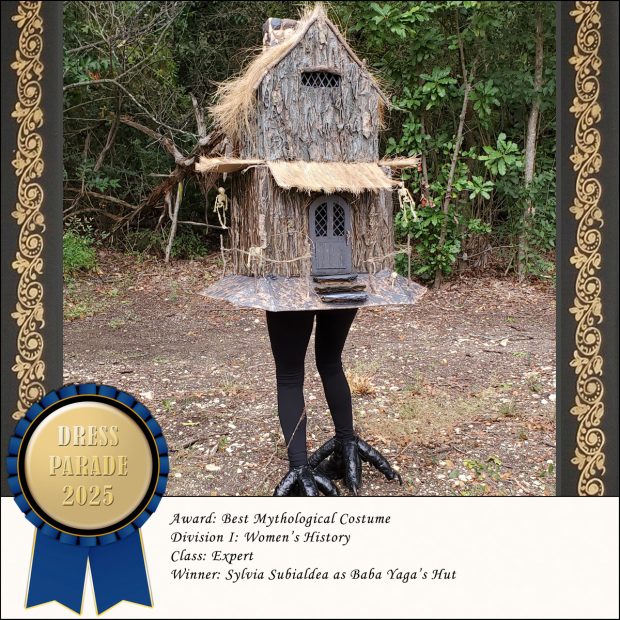
Winner, expert class: Sylvia Subialdea as Baba Yaga’s hut.
It’s canon here at Dress Parade that Baba Yaga is her hut; as Marija Gimbutas wrote in The Language of the Goddess, “The hut can turn around on its axis like a spindle and is, in fact, Baba Yaga herself.” So it’s very fitting that Sylvia here is taking what we used to call the Best Goddess prize for this astoundingly cool hut. Everything about this is on point, including the fact that the hut is backwards (or rather, Sylvia is backwards) so that Sylvia’s legs are bent in the correct bird-leg way. Amazing.

Winner, Judge’s Choice: Ursa Sylvest as Hel, the Norse Goddess of Death.
This is so perfect!!! I’ve thought about adding a Hel costume to our website, and I don’t think I could do better than this. I love the skull mask combined with the hangerok; it seems exactly right for Hel. Bonus points for the juniper berries.
Best Notable Woman Costume
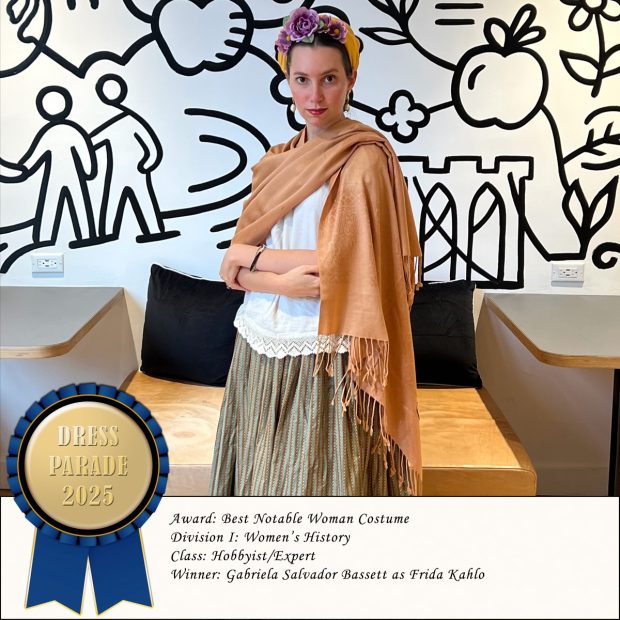
Winner, hobbyist/expert class: Gabriela Salvador Bassett as Frida Kahlo.
I don’t know where Gabriela had this picture taken—it looks like it could be a museum cafe—but the backdrop is perfect for Frida Kahlo. Gabriela is of course an expert costumer, but she felt this was more of a hobbyist level entry; hence the blended class. Regardless, it’s a wonderful outfit pulled off with Gabriela’s typical elegance.
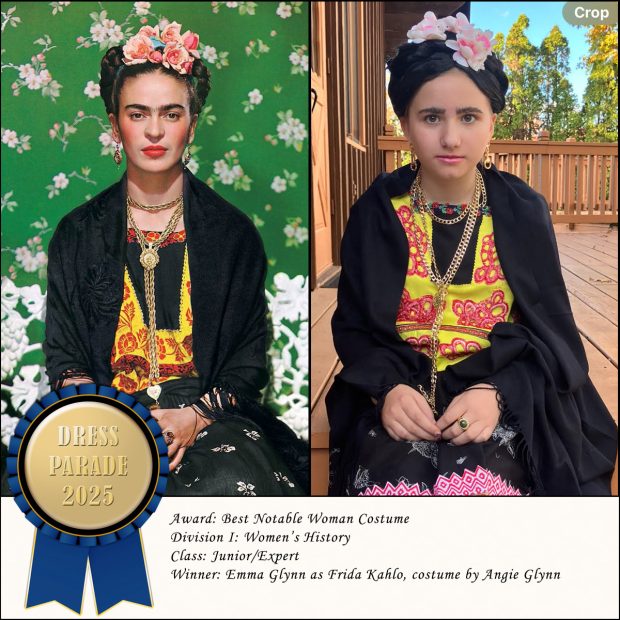
Winner, junior/expert class: Emma Glynn as Frida Kahlo, costume by Angie Glynn.
It’s The Year of the Two Fridas! Angie always creates terrific costumes for Emma, and this year is no exception. That blouse is especially good. Congratulations, Angie and Emma!
Division II: Masquerade
This is for costumes that don’t fit into Division I. The prize categories this year are Period Costumes, Historical Recreation, Fiction, and Fantasy.
Best Period Costume
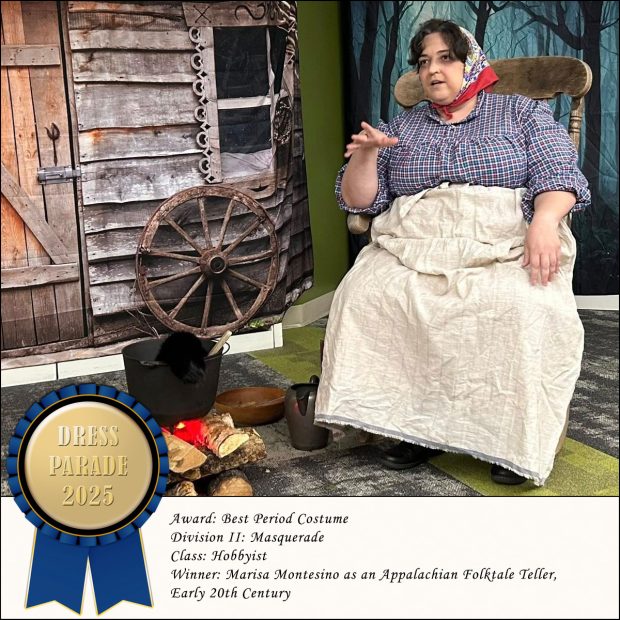
Winner, hobbyist class: Marisa Montesino as an Appalachian Folktale Teller, Early 20th Century.
Marisa made this costume for her library’s literary haunted house, where she told the story of Tailypo. In true authentic style, she made the whole outfit from thrifted fabric, with different material for the top and bottom of the dress. The apron even looks like it could be flour sack material. Great job, Marisa!

Winner, expert class: Monica and Arthur Griffith in French Court Dress, costumes by Monica De Souza-Griffith.
Monica dubbed these marvelous costumes “Purple Passion.” Her creations are always splendiferous, but these particular outfits have a special meaning. As Monica explained in her email entry, “It was a true labor of love because of the purpose behind the creation. A dear close friend, avid patron of the Faire, passed away this year. All of the friends and family gathered at the Faire this year in her honor wearing her favorite color. Of course, purple is violating The Sumptuary Law of the land, but it was well worth the risk of being taken to The Tower :).” Congratulations, Monica, and thank you for sharing your beautiful tribute to your late friend.
Best Historical Recreation
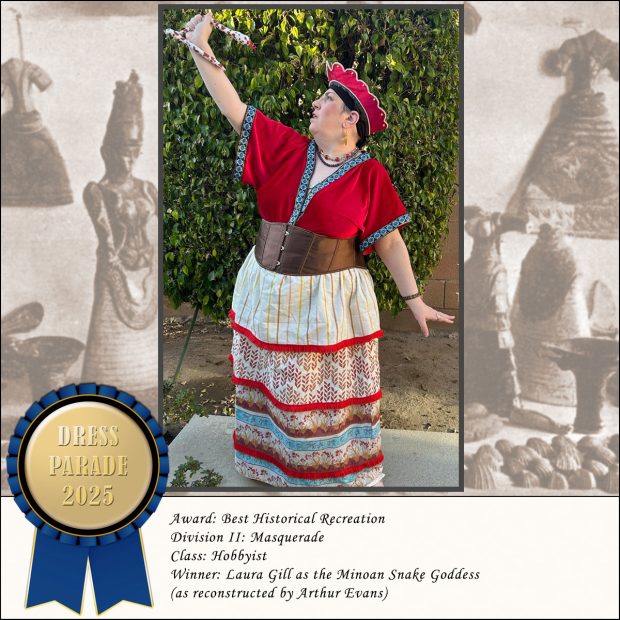
Winner, hobbyist class: Laura Gill as the Minoan Snake Goddess.
This is a reconstruction of a reconstruction, since Arthur Evans kind of dreamed up the Snake Goddess from fragments of figurines he unearthed. Maybe she was a goddess, maybe she was a priestess, maybe…who knows? Anyway, Laura’s interpretation is very sensible, I think, and captures the look without the awkward, um, bosom exposure. I think the bodice is wonderful and the flounced skirt is perfect. Great job, Laura!
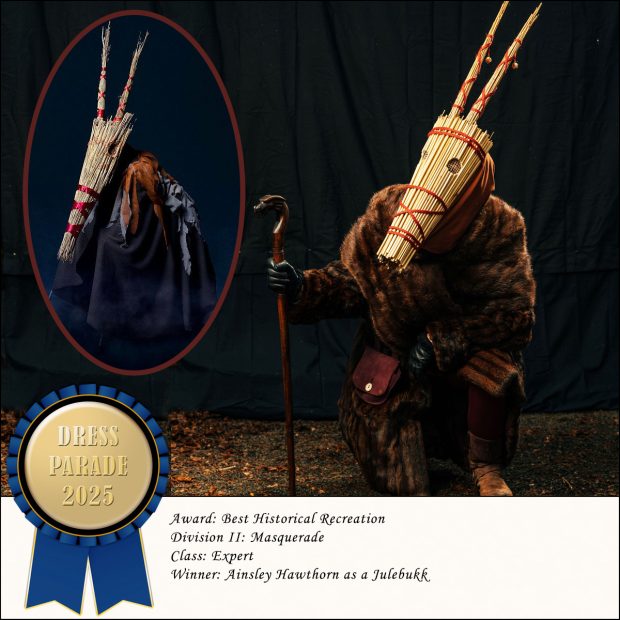
Winner, expert class: Ainsley Hawthorn as a Julebukk.
All hail the Yule Goat! Ainsley explains that “Julebukking was a Nordic house-visiting tradition like mummering, where people dressed in animal skins and straw goat masks would go from door to door entertaining their neighbours and demanding to be fed.” Her mask was specifically inspired by a vintage-style costume from the Moesgaard Museum in Denmark (inset). Isn’t it amazing? Also maybe a little bit terrifying? Just kidding, Ainsley—beautiful work.
Best Fictional Character Costume
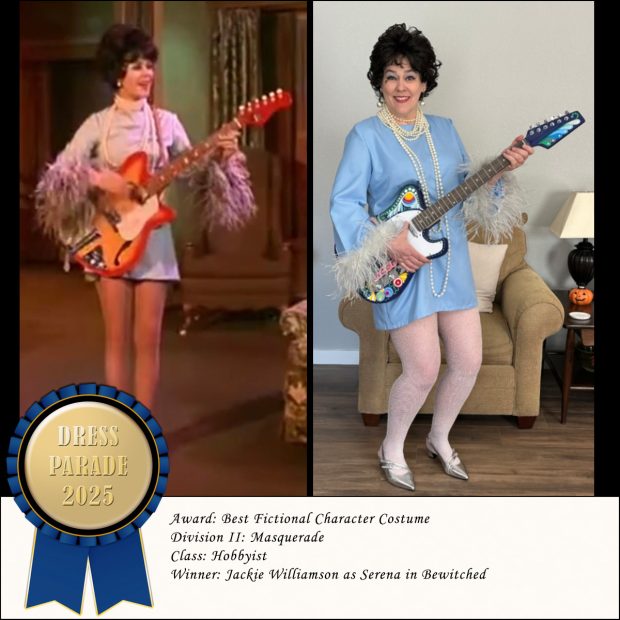
Winner, hobbyist class: Jackie Williamson as Serena from Bewitched.
This is the classic episode in which Cousin Serena plays guitar and sings “I’ll Blow You a Kiss in the Wind.” Jackie made the dress from vintage polyester fabric and painted an old guitar to evoke the hippie vibe of the episode. Great job!
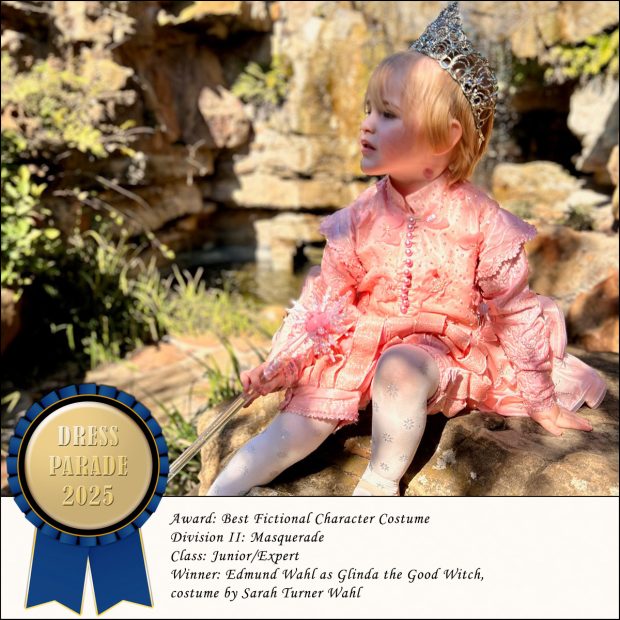
Winner, junior/expert class: Edmund Wahl as Glinda the Good Witch, costume by Sarah Turner Wahl.
Edmund is following up last year’s bravura entry as Elphaba with another Wicked-inspired costume; this year his mom Sarah has turned him into Glinda the Good Witch. As someone on Facebook said, “this child is wearing outfits I want to wear.” We can only hope that when Edmund grows up he will appreciate his mother’s loving devotion and phenomenal sewing-fu.
Best Fantasy Character Costume
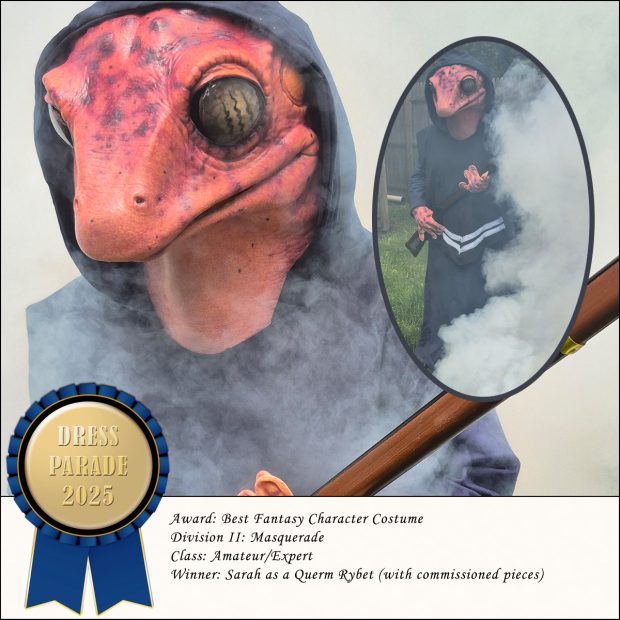
Winner, amateur/expert class: Sarah as a Querm Rybet.
Sarah has pulled together a wonderful costume here, with commissioned pieces from WelshCreations (the marvelous mask and hands) and SparetimecosplayUS (the poncho), and a dress from Burgschneider. Kudos all around for this great look!
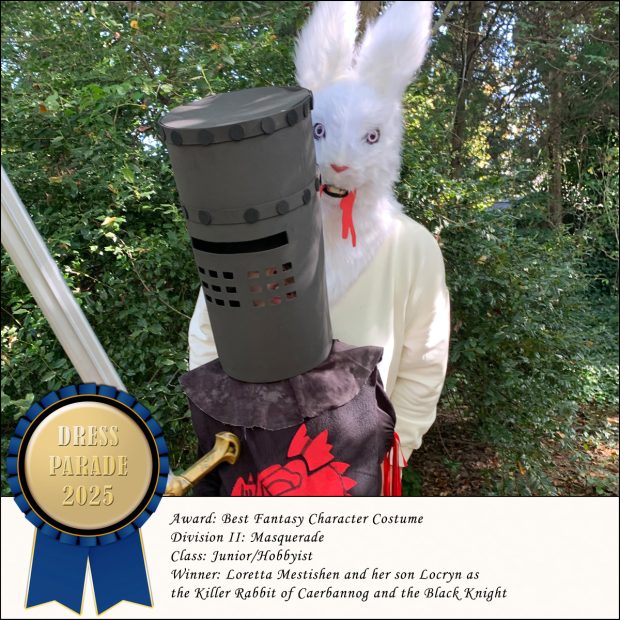
Winner, junior/hobbyist class: Loretta Mestishen and her son Locryn as the Killer Rabbit of Caerbannog and the Black Knight, costumes by Loretta Mestishen.
Run away! Run away! Loretta crafted Locryn’s helmet and tunic from scratch, and adapted the rabbit head “to make it a bit more menacing.” That is, indeed, a menacing rabbit. “That’s no ordinary rabbit!!!”
Okay, folks, that’s it until next year. Happy costuming!
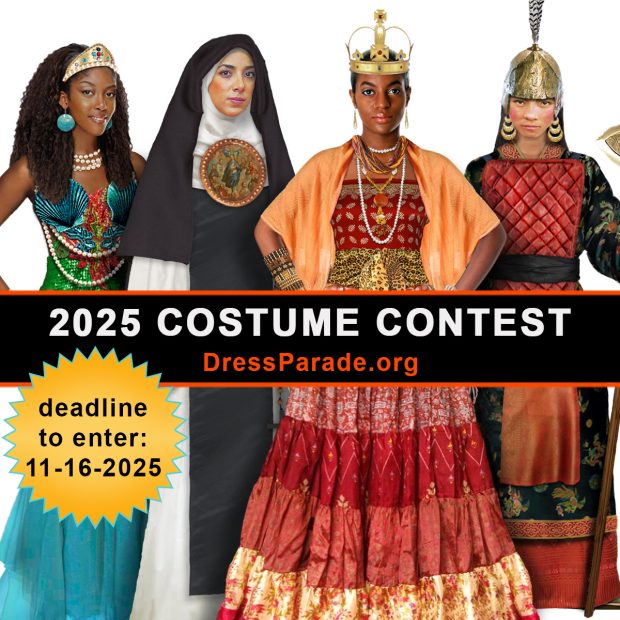
What a difference a year makes. This time last year we were full of hope for the future, looking forward to our first woman president. Now we’re living in a fascist dictatorship and drowning in AI slop. Truly the billionaires have won.
But at least we still have our costume contest! Until the revolution comes (or the civil war, whichever), we can try to cheer ourselves up with feminism and fantasy. As usual, our costume contest this year celebrates the great women of history, along with figures from mythology and fiction. Entries are due by Sunday, November 16, 2025. All the rules below.
Prize Categories
Division I: Women’s History
These are the prize categories that we award every year. They’re based on our own costume categories here on the website: queens, goddesses and mythological figures, notable historical women, and glamorous stars. These should be specific historical people (or beings), not generic costumes. You don’t have to follow one of our costume designs—you can do your own take on any historical figure. But if you do take a crack at recreating one of our designs, you’ll be eligible for the “Best Realization of a Dress Parade Design” award.
- Best Queen Costume
- Best Goddess or Mythological Figure Costume
- Best Notable Woman Costume
- Best Glamour Grrl Costume
- Best Realization of a Dress Parade Design (any category)
Division II: Masquerade
The Masquerade Division is for costumes that don’t fit into Division I. We’re still interested in historical and feminist themes, but there’s no requirement that you represent a specific person from the past.
Period and Folk Costumes: This category is about presenting a particular clothing style from a period or region. Costume periods should be no later than 1975 (50 years ago): Tudor England, Heian period Japan, Mughal India, Viking Age Scandinavia, and the American Civil War era are just a few examples. Folk costumes are traditional dress styles from specific regions, such as the various folk costumes of Greece.
Historical Recreation: This category is about recreating a specific image or artifact from the past, specifically from no later than 1975 (50 years ago). Entries can be silly or serious. Examples include posing to look like a famous painting or photograph, creating a replica of a historic gown, or copying a design from a historic illustration or artifact.
Fictional Characters: This category is for fictional characters from literature, fairy tales, movies, television, or art. Your character should be a basically normal human, such as Elizabeth Bennet in Pride and Prejudice or Queen Ramonda in Black Panther. We really prefer that you not enter anime or video game characters (sorry, it’s just not our thing), but we do allow doll characters from movies (like Barbie). There is no limit on the time period.
Fantasy Characters: The rules are the same as for Fictional Characters, but this category is for non-humans. Mermaids, werewolves, aliens, that sort of thing.
There is obviously a lot of overlap between categories, and most costumes will tick more than one box. Just tell us who or what your costume is supposed to be and we’ll put it in the category where it seems to fit best.
Competition Classes
We award prizes in up to four classes: Amateur, Hobbyist, Expert, and Junior. This is really more about the judging process than anything else; our goal is to ensure that every entry is evaluated fairly and people are competing at their own level. Rest assured that your homemade Athena outfit with a tinfoil helmet is not being judged against an expert costumer’s flawless replica of the Athena Parthenos statue.
Amateur: We expect most entries to fall into this class. These are costumes put together pretty much the same way we created all the costume designs on this website: combining various bits and pieces of existing items, perhaps doing a bit of low-key crafting if necessary.
Hobbyist: These are basically amateur costumes, but with an additional element of intense crafting. Perhaps you constructed your own wings, hand-beaded a collar, or crocheted an entire solar system (yes, that was a thing).
Expert: This is for costumes that exhibit a higher level of skill than amateur. If you’re an experienced cosplayer, Ren Faire person, historical reenactor, or theatrical costumer, your entry is probably expert class.
Junior: This is for competitors age 15 and under, as well as collaborative parent-child efforts.
When you send in your entry, just tell us a little about yourself and your costume so we can figure out where you fit. Note that we won’t necessarily award prizes in all four classes; it just depends on the entries we receive. By the same token, if we need to create a blended class (junior/expert, for example), we will.
Judging and Prizes
Money is very tight this year so we’ve had to reduce the cash value of the prizes. Amateur, Hobbyist, Expert, and Junior winners will each receive a $25 Amazon gift card. If we have a slew of great entries in a particular category, we may award additional Judge’s Choice prizes (also $25).
The deadline for submissions is 11:59 pm EST on Sunday, November 16, 2025. Send your entry email and photos to contact@dressparade.org. You can also email us with questions about the contest, and we may email you for clarification about your costume.
All contest entries will be uploaded to our 2025 Costume Contest Album on our Facebook page. We have found that Facebook is the easiest way to share hundreds of photos with everybody and for everybody to share their favorites with each other. Our Facebook page is also where we will post updates on the progress of the contest, any problems that have arisen, and so forth.
We plan to post the winners by early December. (It’s possible we’ll get it done before American Thanksgiving on November 27, but things have a way of happening.) All winning entries will be announced on Facebook and uploaded to this website.
General Rules
1. You may enter up to three costumes for consideration. You may not submit a costume you have previously entered in our competition.
2. The costume itself must date from no earlier than 2023. That means costumes from 2023, 2024, and 2025 are eligible for this year’s contest.
3. Modern materials and techniques are acceptable in all categories, including period costumes.
4. You are free to use pre-existing garments and store-bought items to construct your costume. There is no requirement to sew or craft anything from scratch.
5. No nudity or overtly sexual content is allowed.
6. Your entry email must include the following information: your name, who or what the costume represents, the category or categories you are aiming for, what competition class you think is appropriate, and at least one large, clear photograph of the costume. If you are entering more than one costume in the contest, you do not have to submit them at the same time or all on the same email.
7. You are welcome to send in multiple photos of your costume, and you can submit additional photos separately from your entry email if necessary. The higher the resolution, the better. Just make sure you identify yourself and your costume in the subject line. Photos should show the costume in full and be clear and well lit. Avoid distracting backgrounds that don’t contribute to your costume.
8. By submitting your photo, you are giving us permission to publish it on the Dress Parade website, our Facebook page, and any other social media. If you’re submitting a contest entry on behalf of someone else, you must have that person’s permission to submit the entry and publish the photo. If other people appear in the photo, you must obtain their permission for us to use and publish it.
9. All entry emails and photos must be sent to contact@dressparade.org no later than 11:59 pm EST on Sunday, November 16, 2025.
Tips
If you’re new to Dress Parade, it might help to look at our contest winners from past years to get a sense of what we like:
2024 Costume Contest winners
2023 Costume Contest winners
2020 Costume Contest winners
2018 Costume Contest winners
2017 Costume Contest winners
2016 Costume Contest winners
2015 Costume Contest winners
2014 Costume Contest winners
2013 Costume Contest winners
2012 Costume Contest winner
Happy costuming!
The time has come! Here are the prizes for this year’s contest. Everyone’s costumes were wonderful and heartfelt, and I only wish I could just give everybody a prize. It’s been a terrible autumn and all the sane people in the country are depressed and in shock, so thank you for participating in the contest. Our little community is an oasis of feminism and decency in this nightmare timeline we seem to be trapped in.
I will be emailing the winners their Amazon gift certificates over the next couple of days. (For reference, here’s the original contest announcement.) All the winners have been posted on our Facebook page and uploaded to our 2024 Costume Contest Winners album. You can also review all the entries this year in our 2024 Costume Contest Album.
Okay, let’s get to it! Here come the prizes!
Division I: Women’s History
These are the prize categories that we award every year. They’re based on our own costume categories here on the website: queens, goddesses and mythological figures, notable historical women, and glamorous stars.
Best Queen Costume

Winner, amateur class: Janice Strickland as Boudicca.
As a longtime member of our community put it, Janice always wows. Or should we say, Janice always slays. For this year’s photo shoot, I understand that she arranged to engage in hand-to-hand combat with a Roman reenactor; that’s his blood on the sword. Okay, just kidding. But this is a perfect costume and an awesome photo shoot.
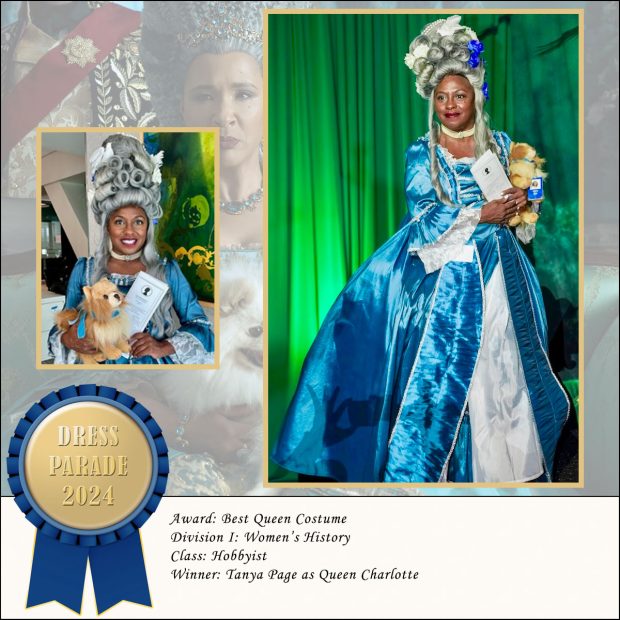
Winner, hobbyist class: Tanya Page as Queen Charlotte.
This is the Bridgerton version of Queen Charlotte, and Tanya put countless hours into creating that incredible wig. It was her first attempt at wig-fu and the result is fabulous. The whole costume is beautifully done. Brava!

Winner, junior/expert class: Emma Glynn as Marie Antoinette, costume by Angie Glynn.
This is the second year in a row that Emma and her mom Angie (the costuming expert) have locked down this category. Such an exquisite ensemble! And the cake looks yummy too. I can’t wait to see which queen they’ll attempt next. Congratulations, Madame and Mademoiselle Glynn!
Best Mythological Costume
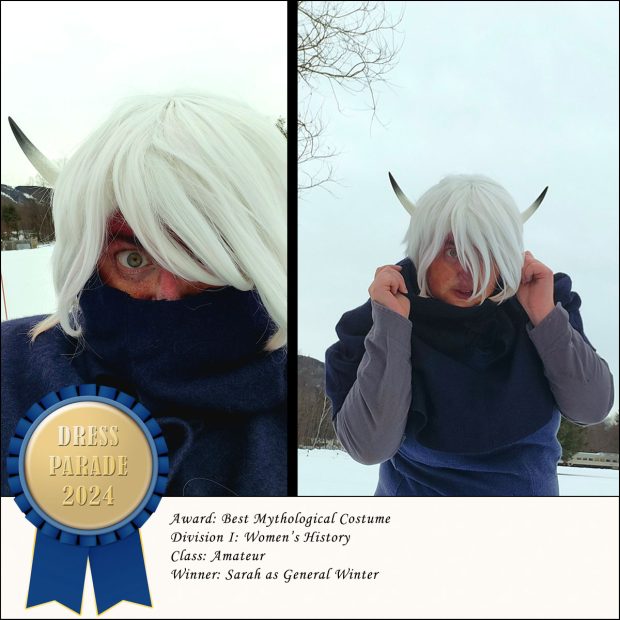
Winner, amateur class: Sarah as General Winter.
This is General Winter as in the spirit of winter, and it’s very much in the amateur spirit of our costumes. Sarah pulled together some blue layers from her closet, donned a sharp white wig and horns, and did bruise makeup on her skin (because cold). Then she drove to the White Mountains in New Hampshire for the photo shoot! A simple yet very effective and neatly executed costume.

Winner, hobbyist class: Becky Murphy as Bastet.
Apart from the wig, sandals, and sheer wrap, every bit of this costume was crafted by Becky herself. The collar, the belt, the sistrum, the whole bit. And to help her channel the spirit of the “original cat lady,” Becky is joined by her cats Trouble (white/tabby) and Finn (white). Very impressive!

Winner, expert class: Kristen Bloschak as Eos.
I absolutely love this costume and this picture. The lights are sewn onto the gold himation, and the marvelous headdress is a confection of zip ties, gold paint, jewelry findings, and glue. It’s perfect. And the photo shoot gives the effect of Dawn rising out of the ocean. Utterly sublime.
Best Reinterpretation of a Dress Parade Design
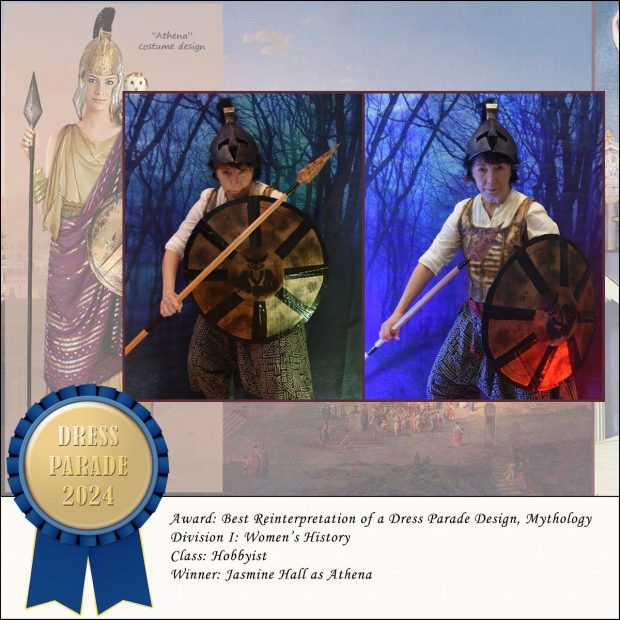
Winner, Best Reinterpretation of a Dress Parade Design, Mythology: Jasmine Hall as Athena.
Don’t you think Athena should wear pants? Jasmine does, and so she created this costume with dhoti-style trousers. The breastplate is a tank top spray-painted gold (which btw is the same technique we recommend for our Freyja costume). Jasmine also decided to paint the owl on the shield, which is much more practical for battle than having a bird on your shoulder. This is altogether a very smartly updated and businesslike Athena outfit!
Best Notable Woman Costume
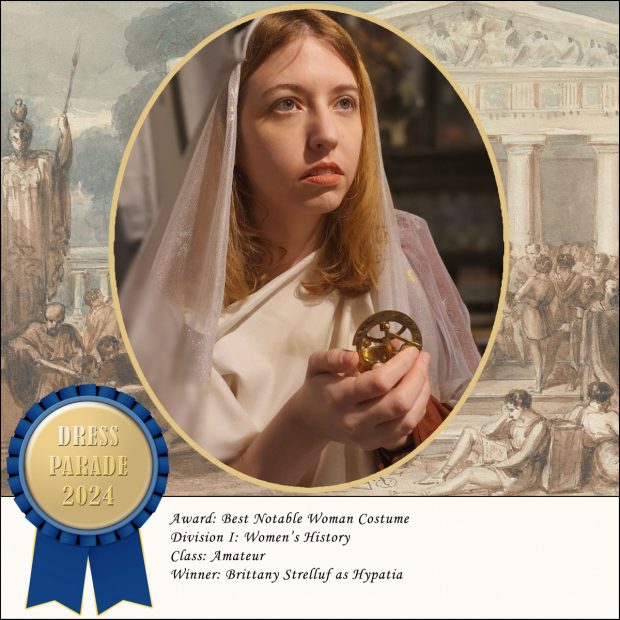
Winner, amateur class: Brittany Strelluf as Hypatia.
Brittany did an absolutely lovely job with this costume. The chiton, the tribon (philosopher’s cloak), the sextant standing in for an astrolabe — every detail is on point! Very evocative photo shoot too.
Best Glamour Grrl Costume

Winner, amateur class: Cheryl Blakemore as Tina Turner.
This costume is so good, I half-believe that’s one of Tina Turner’s actual wigs. I remember sitting in my living room, watching the video for “What’s Love Got To Do With It” on MTV (yes I’m old), and Cheryl here is the very spitting image. Amazing job!
Division II: Masquerade
This is for costumes that don’t fit into Division I. The prize categories this year are Fiction, Fantasy, and Period Costumes. The main difference between Fiction and Fantasy is that the latter is for non-human characters. This can be a surprisingly tricky distinction to parse, but it’s what we aim for. A bee, for example, is not a human. The Wicked Witch of the West, on the other hand, is at least part-human, according to the book/musical Wicked, so…well, whatever. We’re not doing particle physics here.
But first, the prize for period costumes!
Best Period Costume
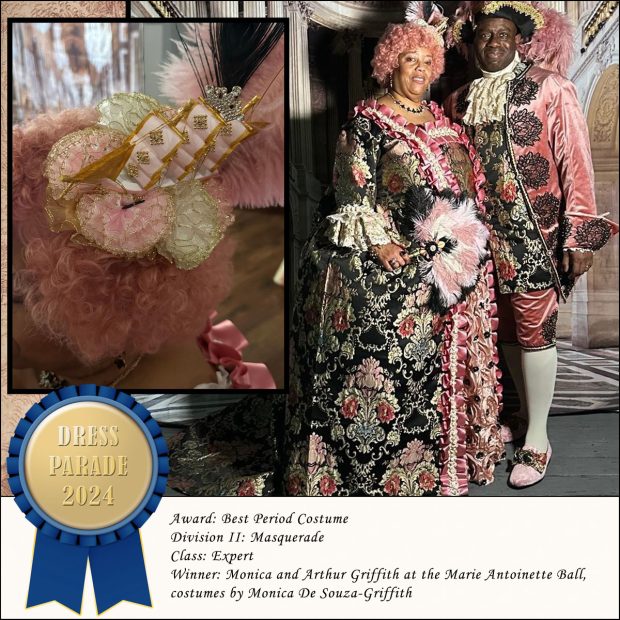
Winner, expert class: Monica and Arthur Griffith at the Marie Antoinette Ball, costumes by Monica De Souza-Griffith.
These marvelous rococo confections from Monica are a symphony of fabric, frills, and furbelows. The inset is a close-up of the exquisite little ship Monica made to wear in her pink wig. Magnifique!
Best Fictional Character Costume
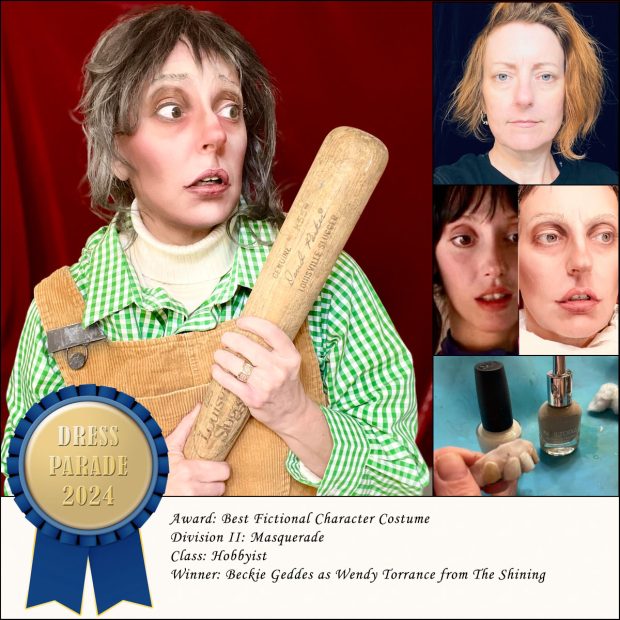
Winner, hobbyist class: Beckie Geddes as Wendy Torrance from The Shining.
Beckie normally doesn’t look anything like Shelley Duvall, which makes this transformation all the more remarkable. It’s all done with makeup and prosthetics, which Beckie made herself. Kudos for an amazing job.

Winner, expert class: Angelica Roque as Cinderella’s Fairy Godmother.
We liked ALL the fairy godmother costumes this year, but Angelica edged out the competition with this lovely ensemble. It’s just so prettily done, and the lighted petticoat gives it a little extra magic. The wig is the perfect finishing touch.
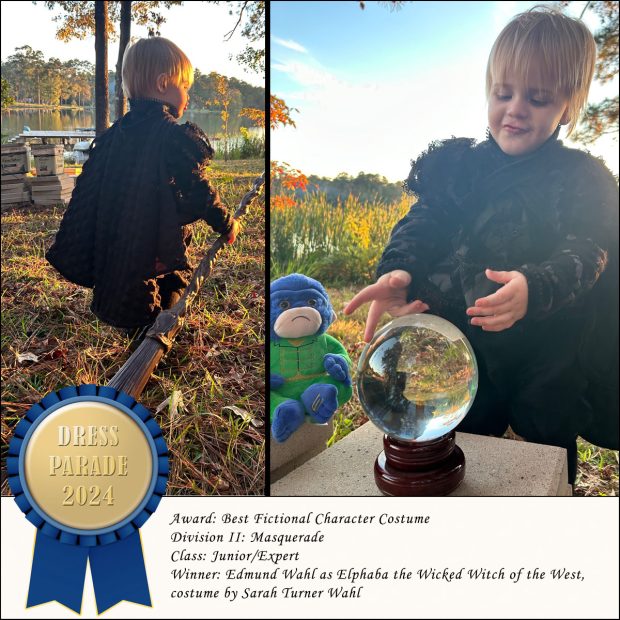
Winner, junior/expert class: Edmund Wahl as Elphaba, costume by Sarah Turner Wahl.
Isn’t he the most adorable Wicked Witch of the West you’ve ever seen? And the costume Sarah created is epic. He looks like the perfect little Renaissance dude. Dude-witch I guess.
Best Fantasy Character Costume
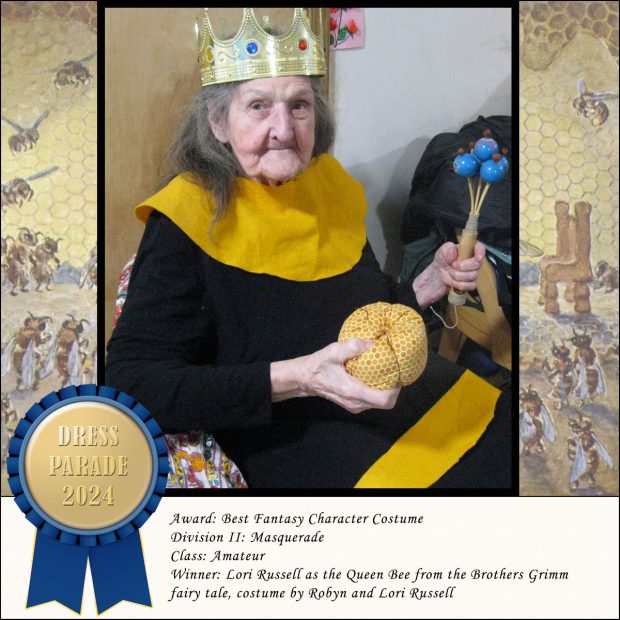
Winner, amateur class: Lori Russell as the Queen Bee, costume by Robyn and Lori Russell.
See, this is how you do a bee costume when you’re 93 years old. You do not mess with complicated makeup or bee prosthetics. You just drape some felt strips strategically across your black dress, accessorize with a crown and some key props, and sell that puppy. Very dignified. Very demure, very mindful.
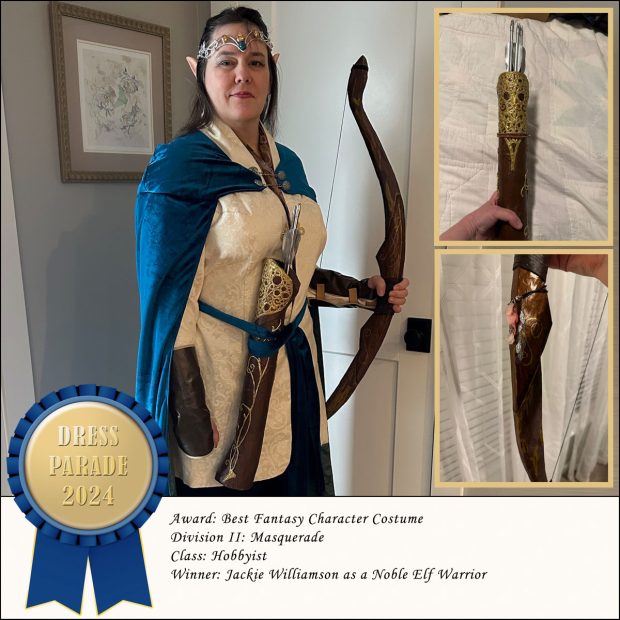
Winner, hobbyist class: Jackie Williamson as a Noble Elf Warrior.
This crisp outfit is completely homemade from thrifted and recycled materials (except for the ears), and Jackie crafted the bow, quiver, and crown herself. Excellent craft-fu!
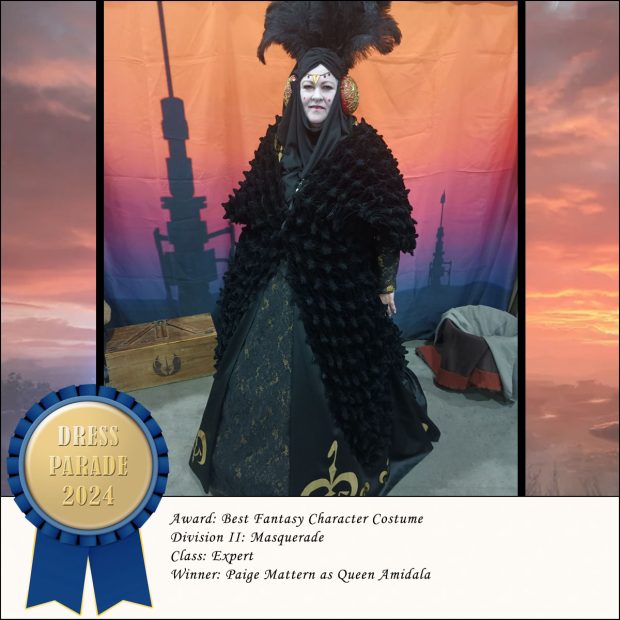
Winner, expert class: Paige Mattern as Queen Amidala.
If I had a costume like this, I think I would just wear it all the time. Just go about my day, running errands, going to the grocery store, whatever. I mean why not? Paige says it took her three or four months to make this costume, which includes “840 hand sewn puffs in velvet.” Wear it to the grocery store, Paige!!!
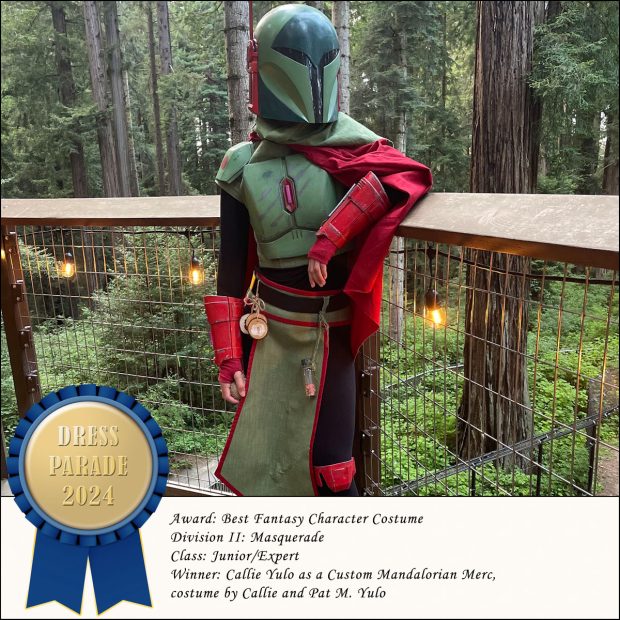
Winner, junior/expert class: Callie Yulo as a Custom Mandalorian Merc, costume by Callie and Pat M. Yulo.
There’s a girl in there! Twelve-year-old Callie Yulo, who collaborated with her mom Pat (an expert cosplayer) on this ensemble. The theme is “Strawberry Matcha,” and no, I don’t really understand the ins and outs of the Mandalorian Merc universe. But this costume is cool!
Division III: When We Fight, We Win!
Well, theoretically at least. This division was created specially this year to celebrate what we all thought was going to happen, so it’s bittersweet to announce a winner. But we do have a winner!
Best “No Balm in Gilead” Costume
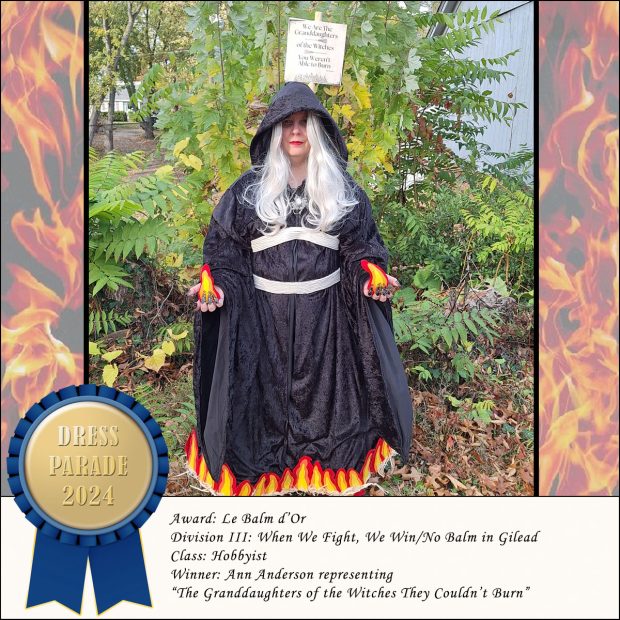
Winner, hobbyist class: Ann Anderson representing “The Granddaughters of the Witches They Couldn’t Burn.”
This is really an incredible ensemble. Ann says the crafting was basic (hot glue, etc.), but there was a LOT of it. She made the flames from felt, used macrame cord to look like rope, glued the straw in place, made the stake, the sign, etc. It’s magnificent! Thank you, Ann, for representing the spirit of unbowed womanhood. We fight on.
Hi everybody! It’s that time of year again: our annual Dress Parade Costume Contest. We’re celebrating women’s history from every era and corner of the globe, along with mythology, fiction, and fantasy. This year we’re awarding prizes in three divisions, with a total prize purse of $1500. Entries are due by November 24 (the Sunday before U.S. Thanksgiving). All the rules below.
(Also, here’s a low-format version of this announcement in case you’re having trouble getting the mobile view to load: 2024 Costume Contest low-format version.)
Prize Categories
Division I: Women’s History
These are the prize categories that we award every year. They’re based on our own costume categories here on the website: queens, goddesses and mythological figures, notable historical women, and glamorous stars. These should be specific historical people (or beings), not generic costumes. You don’t have to follow one of our costume designs—you can do your own take on any historical figure.
- Best Queen Costume
- Best Goddess or Mythological Figure Costume
- Best Notable Woman Costume
- Best Glamour Grrl Costume
Division II: Masquerade
The Masquerade Division is for costumes that don’t fit into Division I. We’re still interested in historical and feminist themes, but there’s no requirement that you represent a specific person from the past.
Period and Folk Costumes: This category is about presenting a particular clothing style from a period or region. Costume periods should be no later than 1974 (50 years ago): Tudor England, Heian period Japan, Mughal India, Viking Age Scandinavia, and the American Civil War era are just a few examples. Folk costumes are traditional dress styles from specific regions, such as the various folk costumes of Greece.
Historical Recreation: This category is about recreating a specific image or artifact from the past, specifically from no later than 1974. Entries can be silly or serious. Examples include posing to look like a famous painting or photograph, creating a replica of a historic gown, or copying a design from a historic illustration or artifact.
Fictional Characters: This category is for fictional characters from literature, fairy tales, movies, television, or art. Your character should be a basically normal human, such as Elizabeth Bennet in Pride and Prejudice or Queen Ramonda in Black Panther. We really prefer that you not enter anime or video game characters (sorry, it’s just not our thing), but we do allow doll characters from movies (like Barbie). There is no limit on the time period.
Fantasy Characters: The rules are the same as for Fictional Characters, but this category is for non-humans. Mermaids, werewolves, aliens, that sort of thing.
There is obviously a lot of overlap between categories, and most costumes will tick more than one box. Just tell us who or what your costume is supposed to be and we’ll put it in the category where it seems to fit best.
Division III: When We Fight, We Win!
This is a special division we’ve created just for costumes related to the 2024 U.S. election. We’re leaving the prize categories open, because it’ll depend on what people send in. But some possibilities are:
Madam President: Dress up as Kamala Harris, Hillary Clinton, Shirley Chisholm, or any of the women who have run for president of the United States. There are quite a few, actually: Victoria Woodhull (the first), Belva Lockwood, Margaret Chase Smith, Patsy Mink, and many more.
Trailblazer Tributes: From Seneca Falls to Black Lives Matter, women have been at the forefront of the fight for civil and human rights. Here’s a chance to honor and celebrate the abolitionists, suffragists, civil rights leaders, feminists, womanists, and glass ceiling breakers who’ve brought us this far.
No Balm in Gilead: Exorcise the evil spirits who want to subjugate women and rob us of our basic rights! Eyeliner/orange makeup optional.
Competition Classes
We award prizes in up to four classes: Amateur, Hobbyist, Expert, and Junior. This is really more about the judging process than anything else; our goal is to ensure that every entry is evaluated fairly and people are competing at their own level. Rest assured that your homemade Athena outfit with a tinfoil helmet is not being judged against an expert costumer’s flawless replica of the Athena Parthenos statue.
Amateur: We expect most entries to fall into this class. These are costumes put together pretty much the same way we created all the costume designs on this website: combining various bits and pieces of existing items, perhaps doing a bit of low-key crafting if necessary.
Hobbyist: These are basically amateur costumes, but with an additional element of intense crafting. Perhaps you constructed your own wings, hand-beaded a collar, or crocheted an entire solar system (yes, that was a thing).
Expert: This is for costumes that exhibit a higher level of skill than amateur. If you’re an experienced cosplayer, Ren Faire person, historical reenactor, or theatrical costumer, your entry is probably expert class.
Junior: This is for competitors age 15 and under, as well as collaborative parent-child efforts.
When you send in your entry, just tell us a little about yourself and your costume so we can figure out where you fit. Note that we won’t necessarily award prizes in all four classes; it just depends on the entries we receive. By the same token, if we need to create a blended class (junior/expert, for example), we will.
Judging and Prizes
Amateur, Hobbyist, and Expert winners will each receive a $50 Amazon gift card. Junior winners will receive a $25 gift card. If we have a slew of great entries in a particular category, we may award additional Judge’s Choice prizes (also $50).
The deadline for submissions is 11:59 pm EST on Sunday, November 24, 2024. Send your entry email and photos to contact@dressparade.org. You can also email us with questions about the contest, and we may email you for clarification about your costume.
All contest entries will be uploaded to our 2024 Costume Contest Album on our Facebook page. We have found that Facebook is the easiest way to share hundreds of photos with everybody and for everybody to share their favorites with each other. Our Facebook page is also where we will post updates on the progress of the contest, any problems that have arisen, and so forth.
We plan to post the winners in early December. All winning entries will be announced on Facebook and uploaded to this website.
General Rules
1. You may enter up to three costumes for consideration. You may not submit a costume you have previously entered in our competition.
2. The costume itself must date from no earlier than 2022. That means costumes from 2022, 2023, and 2024 are eligible for this year’s contest.
3. Modern materials and techniques are acceptable in all categories, including period costumes.
4. You are free to use pre-existing garments and store-bought items to construct your costume. There is no requirement to sew or craft anything from scratch.
5. No nudity or overtly sexual content is allowed.
6. Your entry email must include the following information: your name, who or what the costume represents, the category or categories you are aiming for, what competition class you think is appropriate, and at least one large, clear photograph of the costume. If you are entering more than one costume in the contest, you do not have to submit them at the same time or all on the same email.
7. You are welcome to send in multiple photos of your costume, and you can submit additional photos separately from your entry email if necessary. The higher the resolution, the better. Just make sure you identify yourself and your costume in the subject line. Photos should show the costume in full and be clear and well lit. Avoid distracting backgrounds that don’t contribute to your costume.
8. By submitting your photo, you are giving us permission to publish it on the Dress Parade website, our Facebook page, and any other social media. If you’re submitting a contest entry on behalf of someone else, you must have that person’s permission to submit the entry and publish the photo. If other people appear in the photo, you must obtain their permission for us to use and publish it.
9. All entry emails and photos must be sent to contact@dressparade.org no later than 11:59 pm EST on Sunday, November 24, 2024.
Tips
If you’re new to Dress Parade, it might help to look at our contest winners from past years to get a sense of what we like:
2023 Costume Contest winners
2020 Costume Contest winners
2018 Costume Contest winners
2017 Costume Contest winners
2016 Costume Contest winners
2015 Costume Contest winners
2014 Costume Contest winners
2013 Costume Contest winners
2012 Costume Contest winner
Happy costuming!
Prizes are here! A huge thank-you to everyone who participated in the contest. I’m in awe of all the beautiful costumes, the boundless creativity, and the warm sense of camaraderie in our little community. I was delighted to see so many familiar faces again and thrilled to welcome new participants to our contest.
I will be emailing the winners their Amazon gift certificates over the next couple of days. (For reference, here’s the original contest announcement.) All the winners have been posted on our Facebook page and uploaded to our 2023 Costume Contest Winners album. You can also review all the entries this year in our 2023 Costume Contest Album.
Okay, let’s get to it! Here come the prizes!
Division I: Women’s History
These are the prize categories that we award every year. They’re based on our own costume categories here on the website: queens, goddesses and mythological figures, notable historical women, and glamorous stars. Except that this year we didn’t get any “glamour grrrl” entries — not complaining, mind you — so we had money left over to bring back one of the traditional awards we had dropped: Best Realization of a Dress Parade Design. Which was perfect, because this year we had some doozies.
Best Realization of a Dress Parade Design
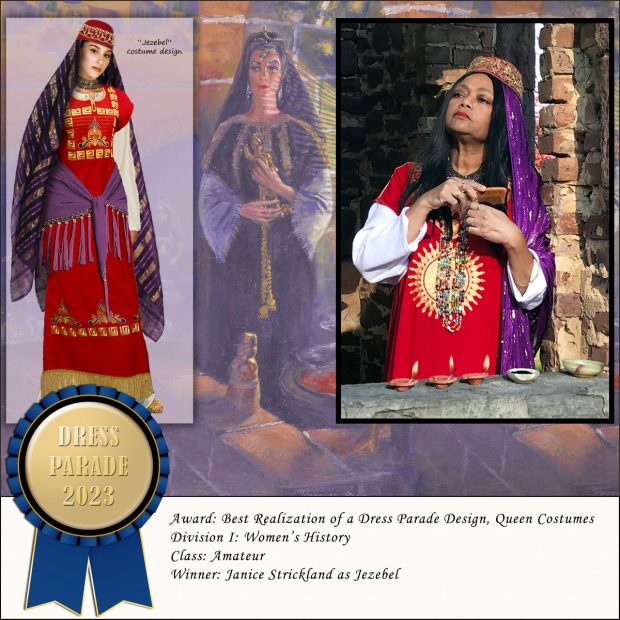
Winner, Best Realization of a Dress Parade Design, Queen Costumes: Janice Strickland as Jezebel.
To fully appreciate the scale of Janice’s achievement here, you have to realize that not only did she perfectly recreate our original costume, she also had a stone tower built to match the illustration. Okay, maybe that last part isn’t true. But the art direction for this shoot is just off the charts. I’m in awe. Thank you, Janice, for bringing to life one of our oldest and most beloved costume designs.
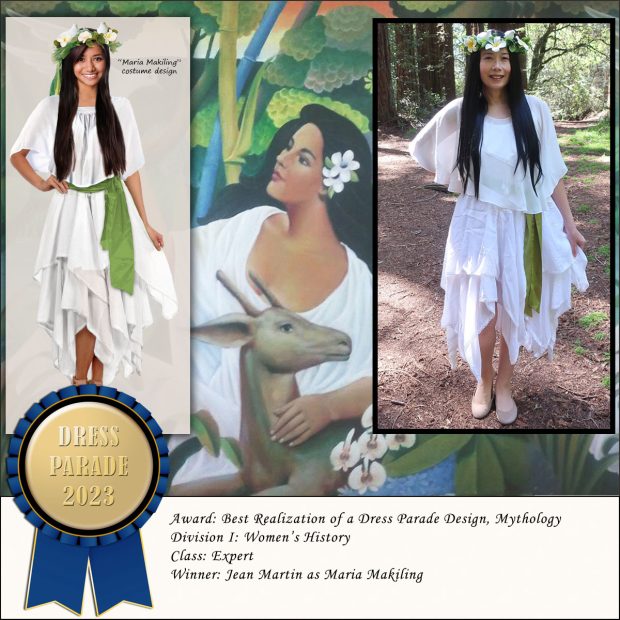
Winner, Best Realization of a Dress Parade Design, Mythology: Jean Martin as Maria Makiling.
Another flawless recreation of one of our costume designs! Jean wore this costume to “Baba Yaga’s Forest Tea Party” (doesn’t that sound like fun?) held by the Greater Bay Area Costumers Guild, and then wrote it up for an issue of Journey Planet devoted to Filipino myths, legends, and folktales. Such a thrill for us!
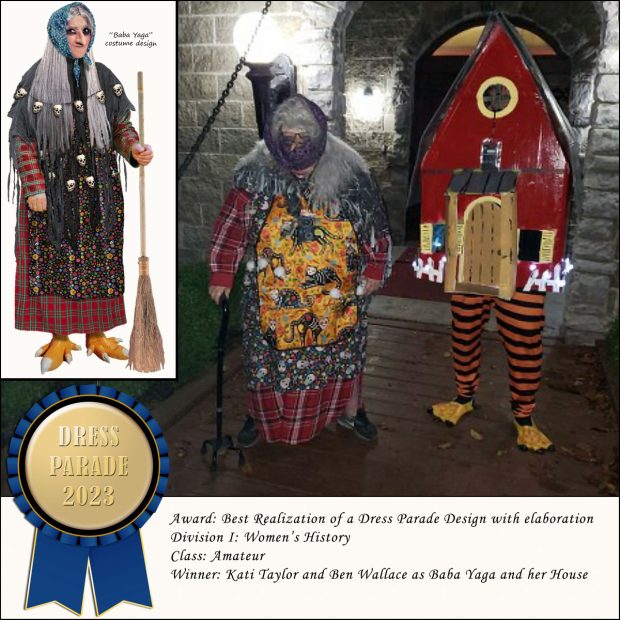
Winner, Best Realization of a Dress Parade Design with Elaboration: Kati Taylor and Ben Wallace as Baba Yaga and her House.
When we debuted our Baba Yaga costume 10 years ago, the chicken feet were a little bit controversial. Traditionally it’s Baba Yaga’s hut that has chicken legs; we justified our design with reference to Marija Gimbutas (who wrote, in The Language of the Goddess, “The hut can turn around on its axis like a spindle and is, in fact, Baba Yaga herself.”) Besides, how else are you going to work the chicken legs into the costume if you’re just one person? But Kati and Ben are two people. They approached this as a couples costume, with Ben essaying the role of Baba Yaga’s hut. Very effective!
Best Queen Costume
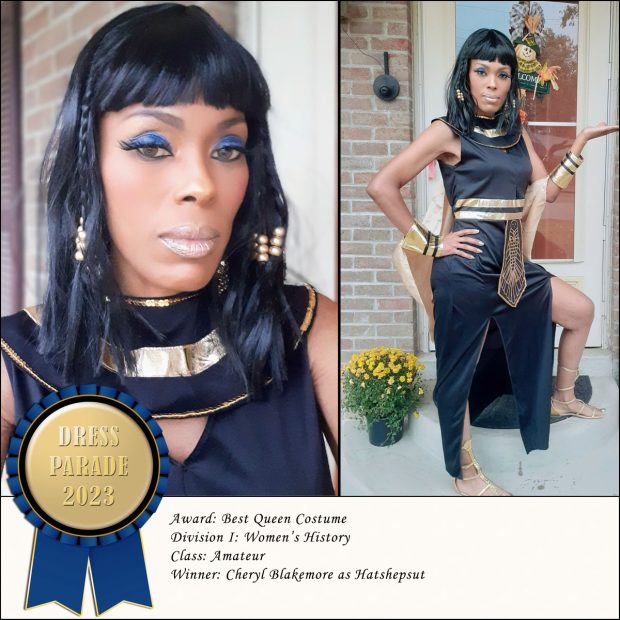
Winner, amateur class: Cheryl Blakemore as Hatshepsut.
I’m willing to bet that the real Hatshepsut wasn’t nearly this beautiful. But the fabulous Cheryl Blakemore brings glamour to everything she does, including Egyptian cosplay. This Hatshepsut is gorgeous and elegant!
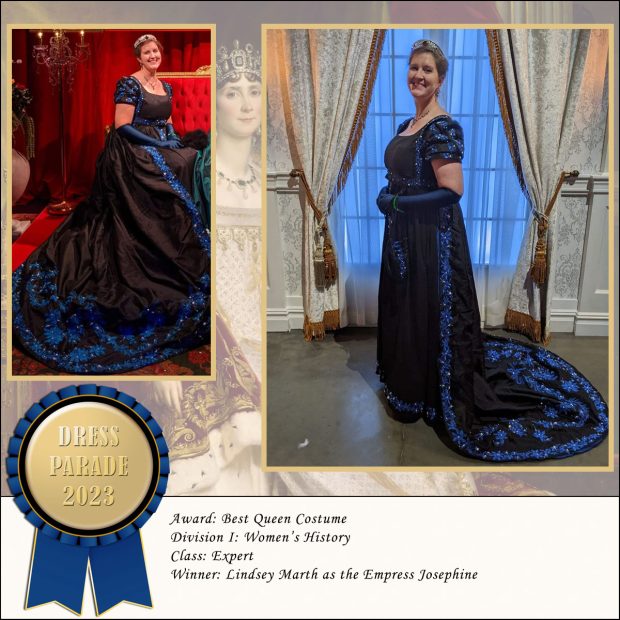
Winner, expert class: Lindsey Marth as the Empress Josephine.
Look at that train! Look at that embroidery! What a spectacular costume. The color scheme is sublime: notice the dark blue gloves that pick up the blue of the embroidery. Just lovely.
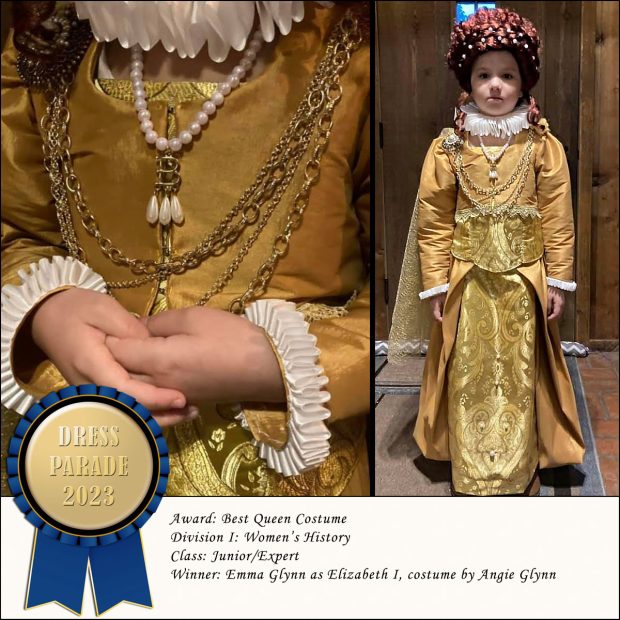
Winner, junior/expert class: Emma Glynn as Elizabeth I, costume by Angie Glynn.
I’m calling this one junior/expert class because of course, mom Angie made the costume. Including the ruffs! Little Emma doesn’t look 100% sold on the concept, but she’s probably just reflecting on the relative discomfort of 16th century garb compared to the ease and convenience of modern knits.
Best Mythological Costume

Winner, amateur class: Brianne Grimstad as Persephone.
Speaking of modern knits: yes, goddesses should wear leggings! And sweatpants! And whatever else they want! In her email to us, Brianne wrote, “I felt if the goddesses and gods were walking among us today, most of them would embrace an updated look.” Yes! Also, Brianne did a bang-up job on that headdress.
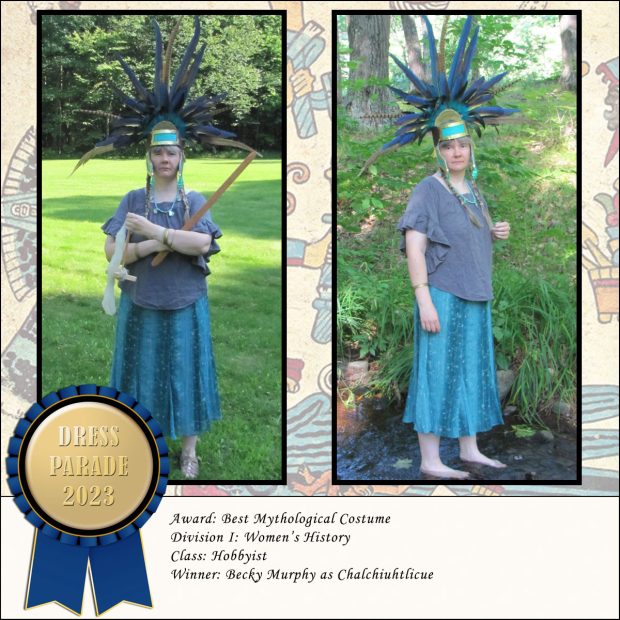
Winner, hobbyist class: Becky Murphy as Chalchiuhtlicue.
Becky has achieved some kind of apotheosis of feathers with this costume, which was inspired partly by our design and partly by the Aztec headdresses you see in modern parades. She made that thing from scratch! Serious feather-wrangling here.
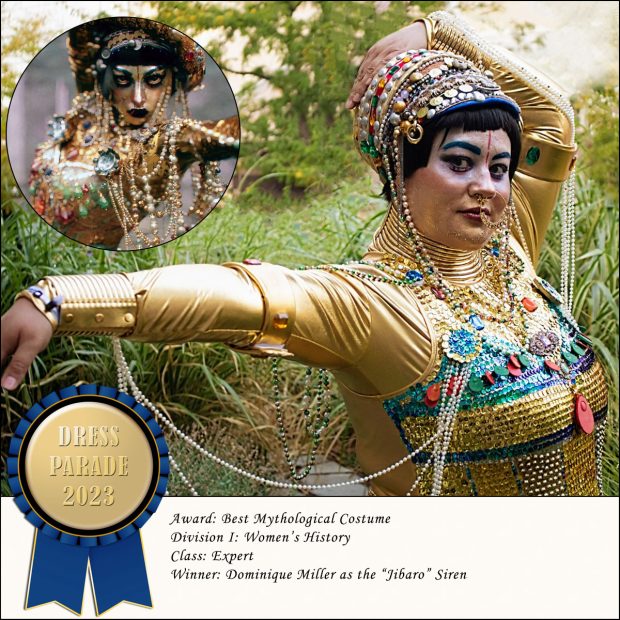
Winner, expert class: Dominique Miller as the Siren from “Jibaro.”
I just don’t know how this could be any more perfect. Everything about it is marvelous: the meticulously crafted headdress, the hand-strung beads, the hundreds of sequins and rhinestones, the handmade armbands that perfectly match the suit, etc. etc. Glorious!

Winner, Judge’s Choice: Caroline Chinitz as a biblically accurate seraph.
Be not afraid, saith the Lord. Wait, why are you screaming?
In all seriousness, I love this costume. Part-insect, part-bird, part-quilted coverlet, it’s a perfect evocation of Ezekiel’s vision. My only question is if Caroline also did hooves for her feet.
Best Notable Woman Costume
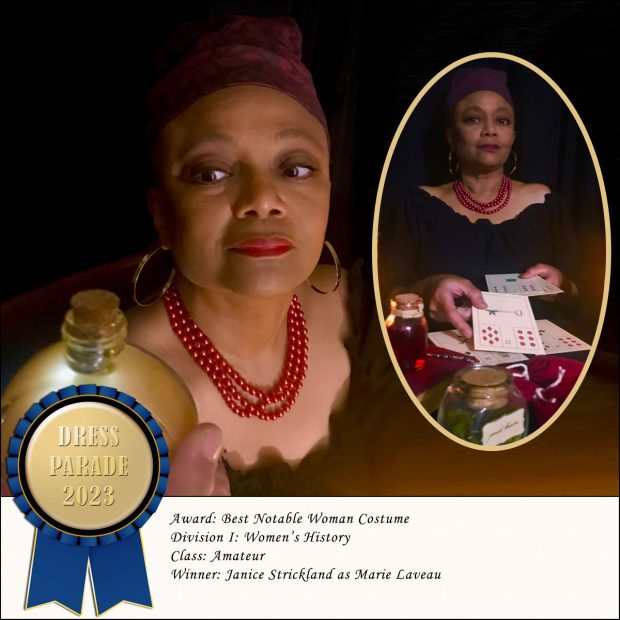
Winner, amateur class: Janice Strickland as Marie Laveau.
Should Janice have been an actress or what? And an art director, because this is another fantastic photo shoot. The props, the lighting, the ambiance — you really feel like you’re getting a peek at the great Voodoo Queen of New Orleans. Brava!
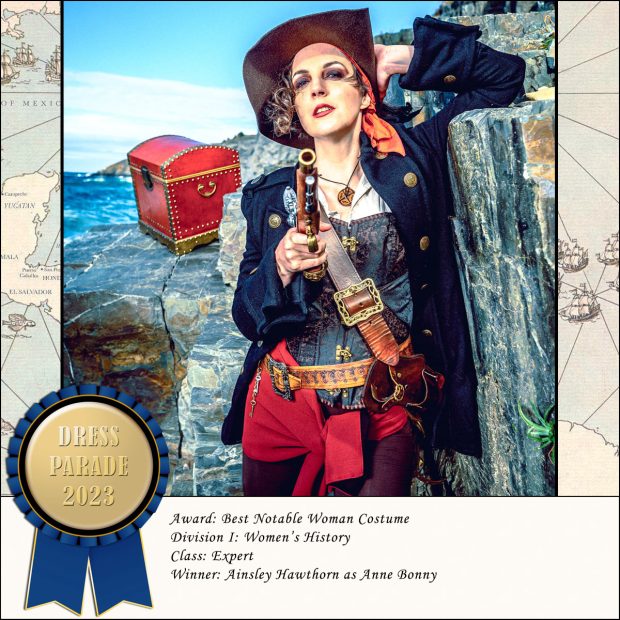
Winner, expert class: Ainsley Hawthorn as Anne Bonny.
Now that’s a pirate costume! Everything from the muslin shirt and wool frock coat to the replica flintlock pistol is right on point. And the photos (by Ritchie Perez I think?) are fantastic!
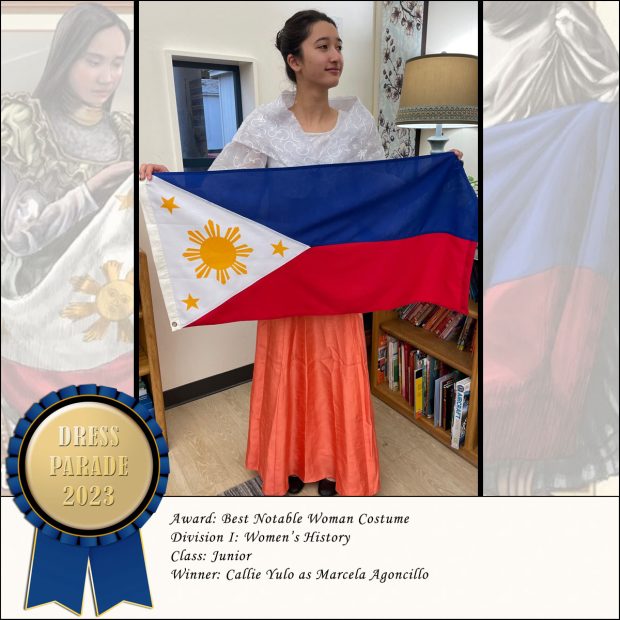
Winner, junior class: Callie Yulo as Marcela Agoncillo.
Marcela Agoncillo is revered in history as the woman who sewed the first Philippine flag. She’s a Philippine national hero, and Callie here has done a lovely job of honoring her legacy. It’s so great to see girls celebrating women’s history and paying tribute to our foremothers. Go, Callie!

Winner, Judge’s Choice: Tabitha Langer as Meow-rie Curie.
Speaking of celebrating women’s history, we have to give a nod to Meow-rie Curie. Because it’s hilarious. Tabitha, who is 8, couldn’t decide between being a cat or Marie Curie for Halloween, so she decided to combine them. This makes perfect sense. Indeed, if Marie Curie were alive today, I have no doubt she would wear cat ears on Halloween. You go, Tabitha!
Division II: Masquerade
This is for costumes that don’t fit into Division I: Fiction, Fantasy, Period Costumes, and Historic Recreations. The main difference between Fiction and Fantasy is that the latter is for non-human characters. Since science has proven that the so-called “humans” in Star Wars are really humanoid bees, we decided to put all the Star Wars costumes in the Fantasy category. Just so you know.
But first, the historic recreations and period costumes!
Best Historical Recreation
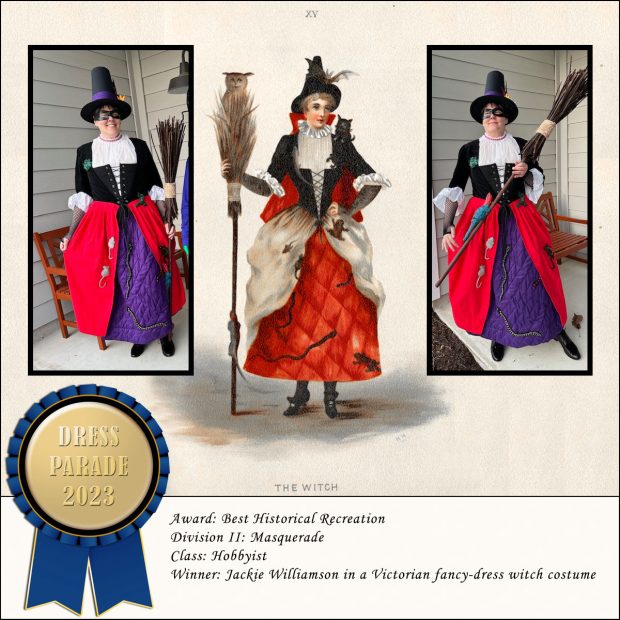
Winner, hobbyist class: Jackie Williamson in a Victorian fancy-dress witch costume.
This is some fine, fine costuming right here. Jackie sewed the garments herself, made the hat out of cardboard, made the lizard out of paper mache, made the little creepy-crawlies out of felt — and it’s wonderful. Completely charming and beautifully done.
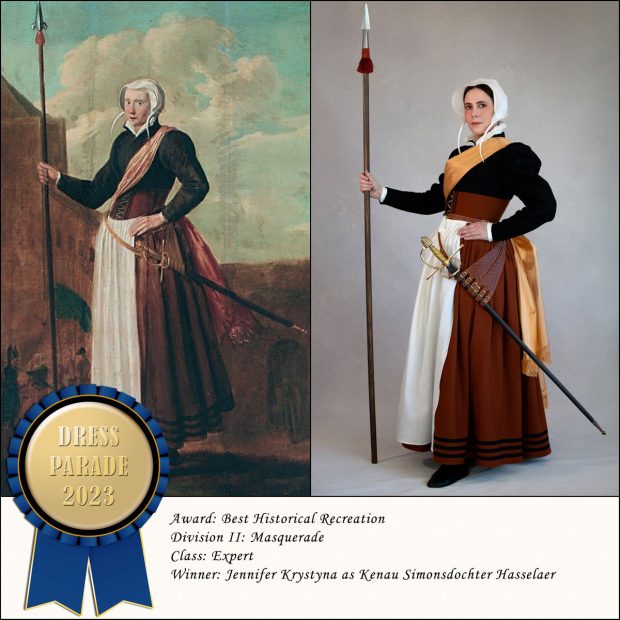
Winner, expert class: Jennifer Krystyna as Kenau Simonsdochter Hasselaer.
I literally gasped when this entry came in. Isn’t it perfect? It’s so clean and elegant — the reconstruction itself, the photo shoot, everything. Kenau was a hero during the siege of Haarlem (1572-73), and it’s sad that her name in Dutch has come to mean something like “bossy bitch.” Maybe we can take it back! Btw, Jenn included a write-up about this costume on her Wasted Weeds blog.
Best Period Costume

Winner, expert class: Angelica Roque in “Victorian Felicitations.”
I have a theory that complicated dress patterns were one of the ways middle-class women in the pre-feminist era kept themselves from going insane. Gotta use that brainpower somehow. The 1840s were the peak of this: everybody was making these wild plaid dresses with fan fronts and darts that must have been a nightmare to match and sew. Angelica here has flawlessly recreated the style, with a dress that is beautifully designed and stitched. Look at that chevron on the front! Look at how the pattern reverses on the ruffles! Beautiful work.
Best Fictional Character Costume
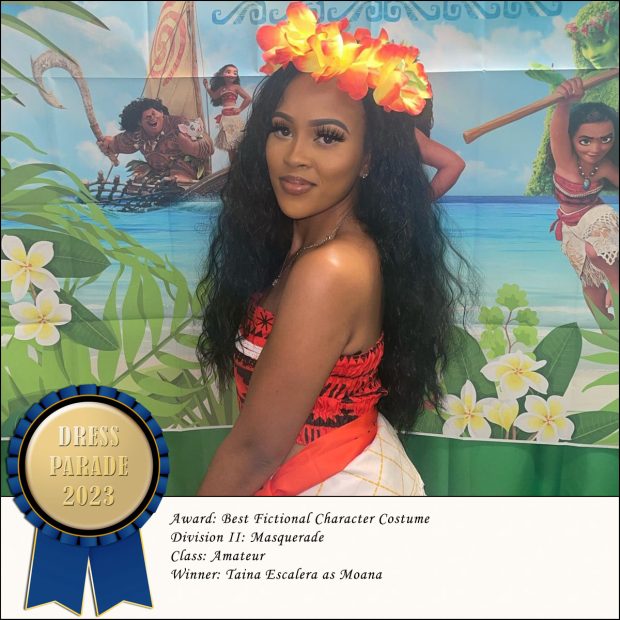
Winner, amateur class: Taina Escalera as Moana.
Taina completely inhabits the role of Moana — literally. She dressed like this for a child’s Moana-themed birthday party, and I can just imagine the sensation she caused. She’s perfect! I bet she was mobbed by kids begging her to sing “How Far I’ll Go.” (I love that whole soundtrack.)
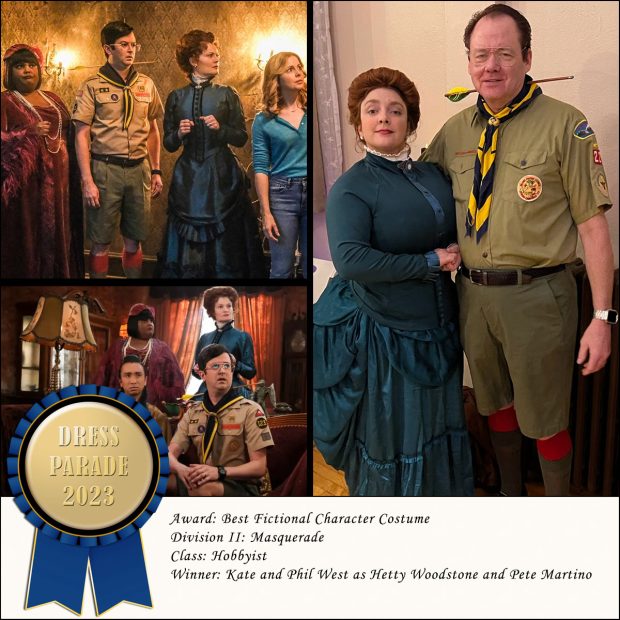
Winner, hobbyist class: Kate and Phil West as Hetty Woodstone and Pete Martino.
This is some excellent costume-fu: Kate rigged up her dress by combining a modern skirt and athletic jacket and hacking it into Victorian shape. That’s exactly the technique we’ve been using for some of the new costumes we’re working on to add to the site. And it looks great! Totally Victorian. The bustle, by the way, is a pillow tied around her waist — another costume hack we enthusiastically endorse.

Winner, expert class: Monica and Arthur Griffith as “Renaissance Ravenclaw,” costumes by Monica De Souza-Griffith.
Monica and Arthur show us what House Ravenclaw would have looked like in roughly the 16th century — assuming, of course, that Hogwarts had a genius costumer on staff. These ensembles are absolutely magnificent. I think this is some of the best work Monica has ever done, and that’s saying a lot. Look at the details! Look at the bird appliques!

Winner, Judge’s Choice: Sa’ida for the “Sarah the Goblin Queen” costume she created for Kara Gill.
I’m not exactly a fan of the movie Labyrinth, but I fell in love with this lush, opulent gown Sa’ida created. Sheer split sleeves, lavish skirt swags caught up by jewels, beading everywhere, rich ruby color — it’s just luscious.
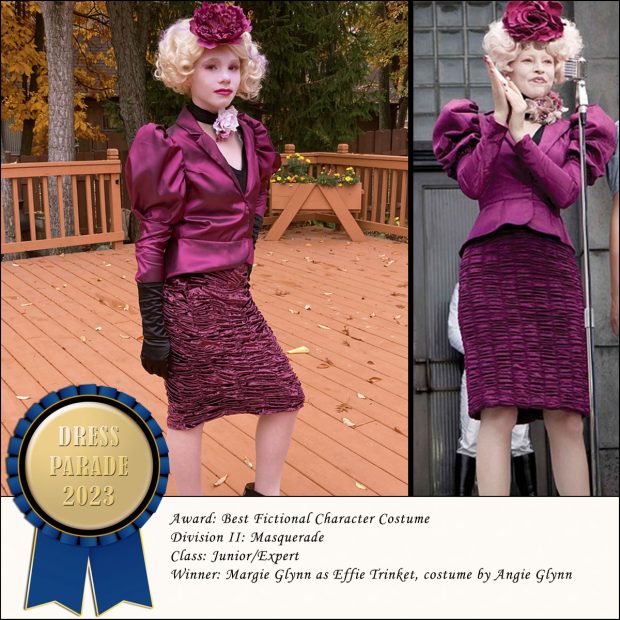
Winner, junior/expert class: Margie Glynn as Effie Trinket, costume by Angie Glynn.
I have unilaterally promoted Angie to expert class because it’s clear she can do anything. Anything! And Margie is doing a fabulous job of selling the costume—she’s got the pose and the attitude down pat. Another triumph from the Glynn family!
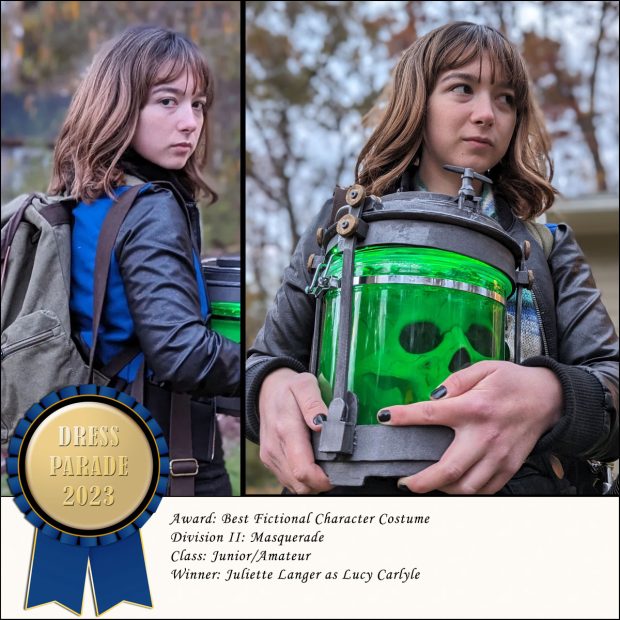
Winner, junior/amateur class: Juliette Langer as Lucy Carlyle.
One of the fun things about holding this contest year after year is seeing kids grow up. Juliette first entered our contest nine years ago as the fiercest little Athena you ever saw. She had a pizza circle for a shield and some kind of aluminum foil situation as a helmet. It was epic. Now here she is, a grown-up young lady, with genuinely excellent costume chops. She made the skull jar housing herself, cut and styled the wig, and pulled together all the clothing items to match Lucy Carlyle (with mom Emily Langer adding some fabric patches to the jacket). Great job, Juliette!
Best Fantasy Character Costume
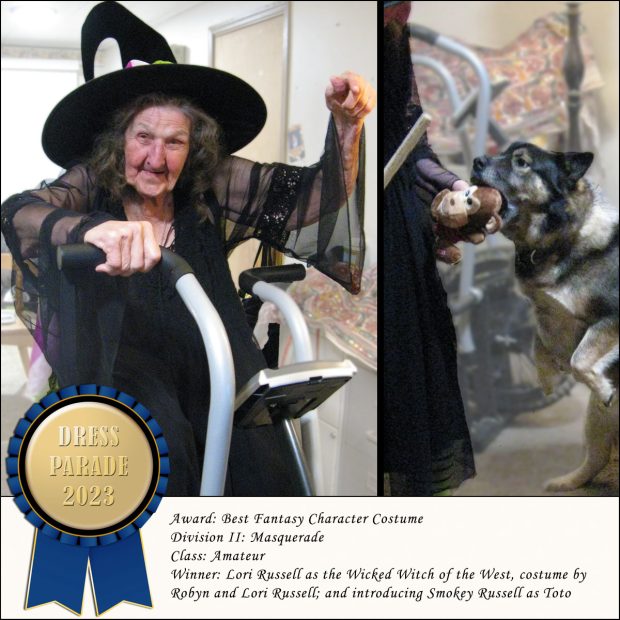
Winner, amateur class: Lori Russell as the Wicked Witch of the West, costume by Robyn and Lori Russell; and introducing Smokey Russell as Toto.
In case you missed it when this entry first came through, Lori is 92 years old. 92! She first entered our contest in 2013, and since then it’s become something of a tradition for the Russell family, with Lori and daughter Robyn collaborating on costumes ranging from Baba Yaga to Madame Defarge. I can’t tell you how thrilled I was to see Lori and Robyn participating again this year. A fancy photo shoot was out of the question given the weather in Alaska, so Robyn and Lori (and Smokey) did a quick indoor version. And you know what? It’s perfect. No notes.
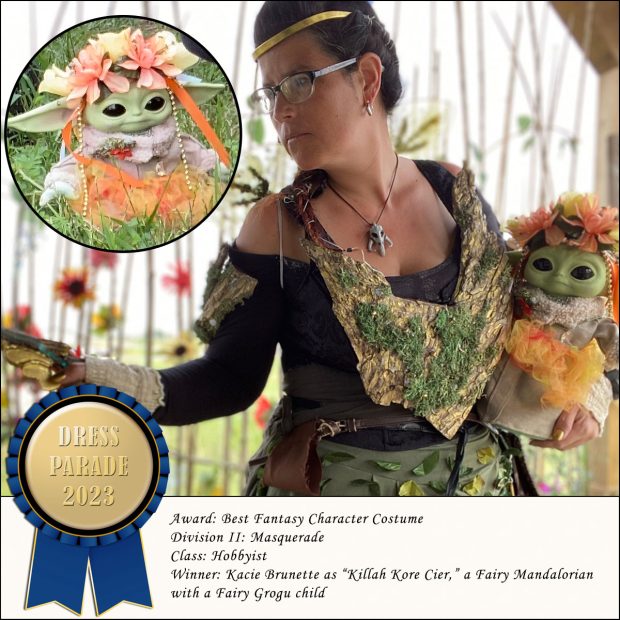
Winner, hobbyist class: Kacie Brunette as a Fairy Mandalorian with a Fairy Grogu child.
I admit, I’m in love with Fairy Grogu. But don’t get me wrong: this whole costume is a winner. I love how imaginatively detailed it is — the bark armor, the threads of gold everywhere, the mossy wings, the leafy skirt. The addition of Fairy Grogu — which is both hilarious and endearing — elevates it into the stratosphere.
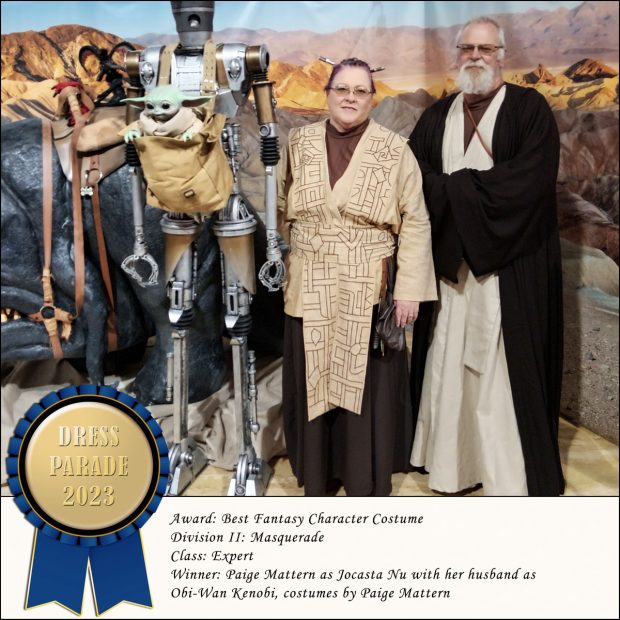
Winner, expert class: Paige Mattern as Jocasta Nu with her husband as Obi-Wan Kenobi, costumes by Paige Mattern.
Competition at the expert level can be fierce, and we had some amazing entries this year. It’s the embroidery that put this one over the top: Paige created the pattern herself from looking at movie stills. Didn’t she do a great job? Beautiful work!
Division III: Main Character Energy
Surprise! We created an extra division for four fabulous costumes that clearly deserve to be the center of their own cinematic universes.
Best Heartthrob
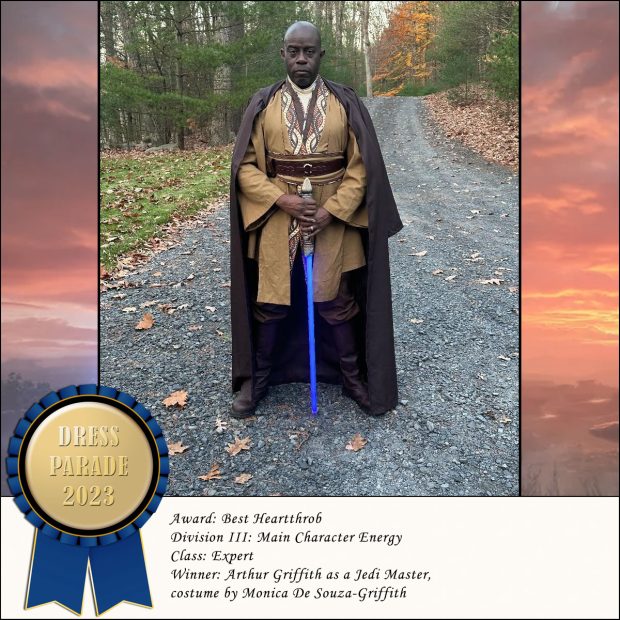
Winner, expert class: Arthur Griffith as a Jedi Master.
Arthur Griffith stars as a Jedi Master on a time-warped journey to the Milky Way, where he meets and falls in love with Monica De Souza at a Renaissance Faire.
Best Villain
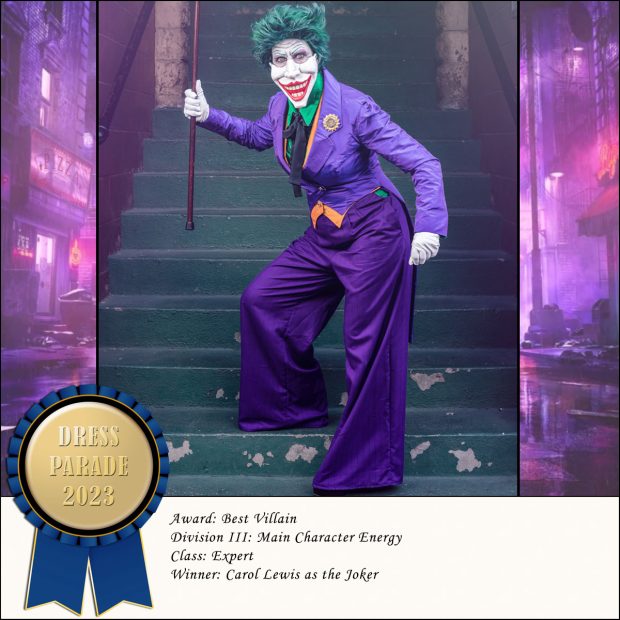
Winner, expert class: Carol Lewis as the Joker.
Carol Lewis stars as the Joker, now female and determined to wreak more havoc than ever on Gotham City.
Best Mascot

Winner, expert class: Ainsley Hawthorn as an ostrich.
Ainsley Hawthorn stars as a mascot performer who starts to believes she really is an ostrich, in a harrowing psychological drama about one woman’s descent into madness.
Best Spiritual Guru

Winner, junior/expert class: Emma Glynn as Weird Barbie, costume by Angie Glynn.
Emma Glynn stars as Weird Barbie, in a 10-film franchise that eventually reveals the mangled doll as the trillion-year-old deity who kicked off the Big Bang.
It’s time for the annual Dress Parade Costume Contest! This is the first year with our new name, but it’s still the same contest. We’ve tweaked the categories and the rules just a teensy bit as part of our never-ending quest to make things simpler and clearer.
This year we have eight prize categories spread over two divisions, with a total prize purse of $1500. Whee!
Prize Categories
Division I: Women’s History
These are the prize categories that we award every year. They’re based on our own costume categories here on the website: queens, goddesses and mythological figures, notable historical women, and glamorous stars. These should be specific historical people (or beings), not generic costumes. You don’t have to follow one of our costume designs—you can do your own take on any historical figure.
- Best Queen Costume
- Best Goddess or Mythological Figure Costume
- Best Notable Woman Costume
- Best Glamour Grrl Costume
Division II: Masquerade
The Masquerade Division is for costumes that don’t fit into Division I. We’re still interested in historical and feminist themes, but there’s no requirement that you represent a specific person from the past.
Period and Folk Costumes: This category is about presenting a particular clothing style from a period or region. Costume periods should be no later than 1973 (50 years ago): Tudor England, Heian period Japan, Mughal India, Viking Age Scandinavia, and the American Civil War are just a few examples. Folk costumes are traditional dress styles from specific regions, such as the various folk costumes of Greece.
Historical Recreation: This category is about recreating a specific image or artifact from the past, specifically from no later than 1973. Entries can be silly or serious. Examples include posing to look like a famous painting or photograph, creating a replica of a historic gown, or copying a design from a historic illustration or artifact.
Fictional Characters: This category is for fictional characters from literature, fairy tales, movies, television, or art. Your character should be a basically normal human, such as Elizabeth Bennet in Pride and Prejudice or Queen Ramonda in Black Panther. We really prefer that you not enter anime or video game characters (sorry, it’s just not our thing), but we do allow doll characters from movies (like Barbie). There is no limit on the time period.
Fantasy Characters: The rules are the same as for Fictional Characters, but this category is for non-humans. Mermaids, werewolves, aliens, that sort of thing.
There is obviously a lot of overlap between categories, and most costumes will tick more than one box. Just tell us who or what your costume is supposed to be and we’ll put it in the category where you have the best chance to win.
Competition Classes
We award prizes in up to four classes: Amateur, Hobbyist, Expert, and Junior. This is really more about the judging process than anything else; our goal is to ensure that every entry is evaluated fairly and people are competing at their own level. Rest assured that your homemade Athena outfit with a tinfoil helmet is not being judged against an expert costumer’s flawless replica of the Athena Parthenos statue.
Amateur: We expect most entries to fall into this class. These are costumes put together pretty much the same way we created all the costume designs on this website: combining various bits and pieces of existing items, perhaps doing a bit of low-key crafting if necessary.
Hobbyist: These are basically amateur costumes, but with an additional element of intense crafting. Perhaps you constructed your own wings, hand-beaded a collar, or crocheted an entire solar system (yes, that was a thing).
Expert: This is for costumes that exhibit a higher level of skill than amateur. If you’re an experienced cosplayer, Ren Faire person, historical reenactor, or theatrical costumer, your entry is probably expert class.
Junior: This is for competitors age 15 and under, as well as collaborative parent-child efforts.
When you send in your entry, just tell us a little about yourself and your costume so we can figure out where you fit. Note that we won’t necessarily award prizes in all four classes; it just depends on the entries we receive. By the same token, if we need to create a blended class (junior/expert, for example), we will.
Judging and Prizes
Amateur, Hobbyist, and Expert winners will each receive a $50 Amazon gift card. Junior winners will receive a $25 gift card. If we have a slew of great entries in a particular category, we may award additional Judge’s Choice prizes (also $50).
The deadline for submissions is 11:59 pm EST on Sunday, November 12, 2023. Send your entry email and photos to contact@dressparade.org. You can also email us with questions about the contest, and we may email you for clarification about your costume.
All contest entries will be uploaded to our 2023 Costume Contest Album on our Facebook page. We have found that Facebook is the easiest way to share hundreds of photos with everybody and for everybody to share their favorites with each other. Our Facebook page is also where we will post updates on the progress of the contest, any problems that have arisen, and so forth. (We find Instagram almost impossible to use at this point, but we will try to share major announcements there. We deleted our Twitter account when Elmo let the Nazis in.)
We plan to post the winners by the end of November. All winning entries will be announced on Facebook and uploaded to this website.
General Rules
1. You may enter up to three costumes for consideration. You may not submit a costume you have previously entered in our competition.
2. The costume itself must date from no earlier than 2021. That means costumes from 2021, 2022, and 2023 are eligible for this year’s contest.
3. Modern materials and techniques are acceptable in all categories, including period costumes.
4. You are free to use pre-existing garments and store-bought items to construct your costume. There is no requirement to sew or craft anything from scratch.
5. No nudity or overtly sexual content is allowed.
6. Your entry email must include the following information: your name, who or what the costume represents, the category or categories you are aiming for, what competition class you think is appropriate, and at least one large, clear photograph of the costume. If you are entering more than one costume in the contest, you do not have to submit them at the same time or all on the same email.
7. You are welcome to send in multiple photos of your costume, and you can submit additional photos separately from your entry email if necessary. The higher the resolution, the better. Just make sure you identify yourself and your costume in the subject line. Photos should show the costume in full and be clear and well lit. Avoid distracting backgrounds that don’t contribute to your costume.
8. By submitting your photo, you are giving us permission to publish it on the Dress Parade website, our Facebook page, and any other social media. If you’re submitting a contest entry on behalf of someone else, you must have that person’s permission to submit the entry and publish the photo. If other people appear in the photo, you must obtain their permission for us to use and publish it.
9. All entry emails and photos must be sent to contact@dressparade.org no later than 11:59 pm EST on Sunday, November 12, 2023.
Tips
If you’re new to Dress Parade, it might help to look at our contest winners from past years to get a sense of what we like:
2020 Costume Contest winners
2018 Costume Contest winners
2017 Costume Contest winners
2016 Costume Contest winners
2015 Costume Contest winners
2014 Costume Contest winners
2013 Costume Contest winners
2012 Costume Contest winner
Happy costuming!
The great transition has happened: Take Back Halloween has now become Dress Parade. You’re on our new site, which we’ve been working all summer to get ready. It looks exactly like the old site, but the backend is updated and we have a new server. Now that our innards are good, we can upload new costumes and start thinking about refreshing our site design to be more mobile-responsive. We’ll leave the old site (takebackhalloween.org) up for awhile, but starting next week we’ll put in an automatic redirect to bring visitors here. Our About page has more about how our site has evolved and the reason for the name change.
Queen Victoria (1819-1901) was the second longest-ruling female monarch in history, exceeded only by the late Queen Elizabeth II. People often think of her as the elderly widow of her later years, but the movie The Young Victoria and the ITV series Victoria reminded us that she was frisky once. They also reminded us (if we needed reminding) that being Queen of England involves some absolutely gorgeous clothes and jewelry.
We published our first Queen Victoria costume back in 2011. Nine years later we decided to create an updated version, inspired by a new ball gown at Recollections that was a great match for one of the dresses worn by Jenna Coleman in Victoria. Then COVID intervened, and when we were finally able to publish the new costume design in 2023, Recollections had sold out of that particular color (it was a navy iridescent taffeta). Such are the challenges of hacking together costumes from existing items. But the dress itself is still available, just not in our original color.
The pieces we suggest, from left to right:
 1. Chantelle Victorian Ball Gown. They no longer have this in the navy we used, but the other colors are nice. You can see them a little better at their Etsy shop.
1. Chantelle Victorian Ball Gown. They no longer have this in the navy we used, but the other colors are nice. You can see them a little better at their Etsy shop.
You’ll need a hoop skirt petticoat to make the dress pouf out. A four-bone hoop skirt with ruffles, like this one from Amazon, is a reasonable alternative to a dressmaker or bridal quality hoop skirt, though it won’t give you as much volume. We also suggest a corset or a longline bra to help give you a period-correct rigid torso.
2. Lace cuffs. To create the cuffs, we used tiny safety pins to attach a length of old ruffled lace inside each sleeve of the dress. This gathered lace is very similar to the lace from our stash. But you can use any kind of ruffled trim: organza, tulle, machine lace, eyelet. Just get something that’s about six inches wide so you’ll have room to pin it and still have it make a nice faux undersleeve. A yard or two will be plenty to make both cuffs. Alternatively, you could wear a chemise under your dress that has lace sleeves, and let the cuffs peek out.
3. Stars and garters. On formal occasions Victoria wore her Order of the Garter regalia: blue sash, diamond Garter Star, and diamond sash badge. We used a plain blue sash and a couple of pre-tied bow brooches to recreate the look without breaking the bank. (You can get reproduction Garter regalia, but it’s expensive). We replaced the rhinestone pin on one of the bows with a large brooch in the shape of a Maltese cross; that’s our stand-in for the diamond Garter Star. Wear the sash over your left shoulder, pin the faux Garter Star over your left breast, and pin the other brooch as a badge where the sash crosses at your hip.
4. Anastasia tiara. This kokoshnik-like rhinestone tiara is a reasonably good match for the diamond fringe tiara that Victoria inherited from Queen Adelaide. (The Court Jeweller has an interesting post on the history of the piece.)
5. Rhinestone collet necklace. Queen Victoria inherited a magnificent diamond collet necklace that she subsequently lost in a court battle with her cousin, the King of Hanover; the replacement necklace she had made is now known as the Coronation Necklace. (The Court Jeweller has a good post about that, too.) Emily Blunt is wearing a replica in the screenshot above from The Young Victoria. You can actually buy a replica yourself at Dames a la Mode. But for our costume we used this modern “chunky tennis necklace” from Etsy. That style is in vogue now, so you can also go much cheaper and get an inexpensive rhinestone necklace from Amazon.
6. Off-white matte satin evening gloves. You may also want to carry a lace fan.
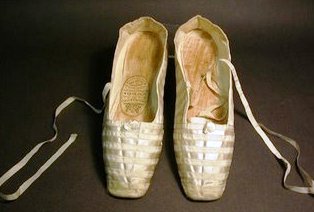 Shoes: Nobody is going to see your feet under that dress! But if you want to keep in period style, wear Isotoner satin ballet slippers. The small picture to the right shows Queen Victoria’s 1840 wedding shoes, which were the same kind of evening shoes all ladies wore in that period. They’re ballet slippers, basically; they even have ribbons. Modern Isotoners are an excellent substitute. Heels started coming back after 1850, but they were very low.
Shoes: Nobody is going to see your feet under that dress! But if you want to keep in period style, wear Isotoner satin ballet slippers. The small picture to the right shows Queen Victoria’s 1840 wedding shoes, which were the same kind of evening shoes all ladies wore in that period. They’re ballet slippers, basically; they even have ribbons. Modern Isotoners are an excellent substitute. Heels started coming back after 1850, but they were very low.
LaSiren, also spelled La Sirène, is the Haitian mermaid goddess of the sea. Her mythological pedigree is impressive: enslaved Africans brought with them the memory of a great female water spirit, combined it with existing Taino legends about a sea creature, and added European mermaid imagery. The result was La Sirène, the reigning queen of the ocean realm. She wears a golden crown, carries a golden trumpet (to play her siren song), and lives in a fabulous underwater palace that’s crammed with sunken treasure. LaSiren herself is a magical vision of beauty, which is exactly what you’ll be in this outfit.
A couple of years ago designer Christian Soriano showed how to make a mermaid costume using a body shaper, a tube skirt, and some squares of organza (the video is below in the Tutorials section). That’s the same basic concept we’re going with here, though our details are different. We’re emphasizing sequins in our design in a nod to the traditional sequined flags of Haitian art (see our illustration above), and piling on regal accessories to suit LaSiren’s queenly status. From left to right:
 1. Sequined bodice. Start with a basic body shaper and paint it to match your skin tone; we used Simply Spray Chestnut Brown Fabric Spray Paint. Then decorate it with some inexpensive sequin appliques, the kind that figure skaters and dancers use on their costumes. In the Tutorials section below we give you a complete list of the appliques you need along with a diagram of how to place them.
1. Sequined bodice. Start with a basic body shaper and paint it to match your skin tone; we used Simply Spray Chestnut Brown Fabric Spray Paint. Then decorate it with some inexpensive sequin appliques, the kind that figure skaters and dancers use on their costumes. In the Tutorials section below we give you a complete list of the appliques you need along with a diagram of how to place them.
2. Mermaid shell bra. This is just a plastic shell bra that’s been transformed with craft paint. Use Martha Stewart High Gloss Pond for the base coat and let it dry. Then brush on some streaks of Deco Art Metallic Ice Blue, allowing some of the base coat show through. Top it all off with a couple of coats of Martha Stewart Turquoise Glitter. Glue the finished shells directly onto your bodice, as we show, or tie them on using the strings that come with the set.
3. Green sequin tube dress to wear as a skirt. Christian Soriano recommends sewing a tube skirt, but of course here at Take Back Halloween we do not sew. Instead we suggest you get a readymade tube dress like this and wear it as a high-waisted skirt. Another option is to make your own tube with a yard of stretchy fabric and a boatload of safety pins; see the Tutorials section below.
4. Turquoise organza fabric. This is what turns your green tube into a mermaid skirt. The video of Christian’s demonstration is in the Tutorials section below, along with some comments from us.
5. Golden trumpet. It’s a plastic vuvuzela covered in Florentine Gold Glitter Paint. You’ll need several coats of the paint to really get good coverage; a base coat of Metallic Gold Paint will help. Also, don’t blow this thing at a party or people will hate you.
6. Gold crown, pearl beads, shell earrings, and coin bracelet(s). Wrap the pearls around your neck a bunch of times and drape them around your bodice. You can also glue a few inches of pearls along the lower edge of the otherwise perfect crown.
Tutorials
It’s not that this costume is hard; it’s just that we have three separate how-to thingies for it and we don’t want you to lose the plot. So we’ve grouped them down here in their own nice little section.
#1: Decorate the bodice with sequin appliques
This is really easy, since the appliques are already beautiful and just need to be pinned/glued on. First, here’s a visual recap of the appliques:
These are all available from Glory’s House:
- Gold Stars (set of 6), .75″ each
- Kelly Green Swirls (mirror pair), 4.25″ x 2″ each
- Red/Orange/Green Flames (mirror pair), 6″ x 3″ each
- Turquoise Flames (mirror pair), 6″ x 2.75″ each
- Red Seaweeds (mirror pair), 6″ x 3.75″ each
This diagram shows how to arrange them on the bodice:
Notice that the appliques are overlapped, which gives a nice dimensional effect. To attach them to the bodice just pin them lightly in the centers and use temporary tack glue to paste them down where necessary. Leave the bottom edge of the whole arrangement hanging free so that when you pull on your skirt the sequins will overlap the waistband. That will make it look all unified and mermaidish. Once you’re dressed you can use some discreet safety pins to keep the bottom edge of the appliques laying flat on your skirt.
#2: Make a no-sew mermaid skirt
If you’re not using a readymade dress or skirt, you can easily whip together your own without sewing. All you need is a stretchy green tube. It should be long enough to go from your high waistline to below your knees (about 30 inches), and wide enough to fit around you snugly. A single yard of green “hologram” spandex or green sequin dot spandex would probably be enough. Instead of sewing it into a tube, just use a close-set line of safety pins:
You can fold the top down inside to make a finished-looking waist. The safety pin seam will be a little bit bumpy, so center it in the back and attach one of the organza squares (next) over it at the bottom.
#3: Transform the tube into a mermaid skirt
Watch Christian Soriano’s demonstration beginning at 2:10:
A couple of notes about that: you don’t have to twist and iron the squares first. And pinning them to your skirt with safety pins is easier than gluing them. Also, we suggest 10 yards of fabric rather than 5 yards, so you can do double-thickness squares and have plenty of fullness to keep your legs from showing. (Horrors! Mermaids don’t have legs!)
Illustration credits: The painting in the upper left is “La Sirène” by Wilson Bigaud. The sequin flag in the upper right is “La Sirène with Plant” by Mireille Delice. The mosaic mural is called “Sea Spirits,” and was created in Jacmel, Haiti, by Laurel True and the Art Creation Foundation For Children (ACFFC).
And: Special thanks to the anonymous Kickstarter backer who commissioned this costume!
Ching Shih, or Madame Ching (1775-1844), has been called the most successful pirate in history. For one thing, there was the sheer size of her operation: her Red Flag Fleet consisted of at least 40,000 pirates, with some estimates ranging as high as 80,000. In terms of power, she was unprecedented: the navies of China, Britain, and Portugal all tried to bring her down, and all failed. But perhaps Ching Shih’s greatest success was that, unlike most pirate captains, she got to retire from piracy with her life and treasure intact. When the Chinese authorities realized that they couldn’t defeat her by force of arms, they offered amnesty instead. Ching Shih negotiated an incredibly favorable settlement for herself and her fleet: everybody got full pardons, everybody got to keep their loot, and the officers were given commissions in the Chinese navy. Ching Shih herself retired from the sea with her riches, and spent the rest of her life running a gambling house.
 Our costume is based on the typical clothing of the day, but with luxurious fabrics befitting Ching Shih’s status. The items we suggest, from left to right:
Our costume is based on the typical clothing of the day, but with luxurious fabrics befitting Ching Shih’s status. The items we suggest, from left to right:
1. Empress Chrysanthemum Jacket in blue. Eyewitnesses reported that high-ranking chiefs in the Red Flag Fleet wore silk brocade, so it stands to reason that Ching Shih, as the boss of the whole shebang, could afford the best.
2. Chinese officer’s hat. Also known as a Mandarin hat. This is a pretty nice hat, once you remove the regrettable braided queue. (Resolved: Hats should not come with attached hair.)
3. Tai chi pants in dark blue. Blue cotton trousers were standard with Chinese soldiers and sailors in the period. Any loose fitting pants will work, since you’re going to tuck them into your leggings (next).
4. Wudang socks. These are sold as martial arts socks now, but they used to be standard garb in China.
5. Wudang shoes. Like the socks, these cotton shoes are a traditional Chinese basic now sold as martial arts gear.
6. Costume sword. This is from the Pirates of the Caribbean franchise.
And speaking of Pirates of the Caribbean: The character of Mistress Ching is said to be loosely based on Ching Shih, though actually the Pirates movies are set about a century earlier. Also, the real Ching Shih wasn’t blind and she wasn’t old. In fact, it’s fascinating to realize that Ching Shih was a young mother during her pirating days. She was in her twenties when she married into the pirate world, and in her early thirties when she rose to become the admiral of the Red Flag Fleet. At the height of her power in 1809, one of her children was a toddler and the other was about six. Talk about having it all!
Illustration credits: The background images in our main illustration are from an extraordinary Qing Dynasty scroll entitled “Pacifying the South China Sea.” This 18-meter scroll, now in the collection of the Hong Kong Maritime Museum, depicts the Chinese government’s campaign against Ching Shih’s pirate fleet from 1808 to 1810. The fanciful British illustration of Ching Shih is from the book History of the Pirates of all Nations, published in 1836. The 1887 woodcut illustration of a pirate is entitled “Capture of a notorious pirate, Chang Yeh, at Hong Kong.” The miniature figurine of a Qing Dynasty soldier is from the Wargames Foundry and was sculpted by Michael & Alan Perry.
Her face is one of the most famous in the world. Nefertiti (ca. 1370–1330 BCE) was the Great Royal Wife of the heretic Pharaoh Akhenaten, and her sublime portrait bust is one of the glories of ancient Egyptian art. The woman herself is still a mystery, although the clues about her are tantalizing. Her prominence during the Amarna Period is unmistakable, and it’s possible she became co-regent with Akhenaten. Even more intriguing is the possibility that she became pharaoh herself: did she take the throne after Akhenaten’s death, perhaps under the name Neferneferuaten? Egyptologists continue to study the question, and what’s exciting is that even now, almost three and half millennia later, new evidence is still being uncovered.
 The good and bad thing about dressing up as Nefertiti is that you really need just one key element: that tall blue crown. This is good because the blue crown is such an inmistakable trademark that you might as well hang a sign saying “Hi, I’m Nefertiti” on your forehead. The bad thing is that it is not particularly easy to make one of those crowns. We’ve experimented with everything from popcorn buckets to posterboard. What we ended up liking the best, believe it or not, is a lampshade. It’s easy as pie because it fits right on the head, the fabric is elegant, and it doesn’t require crafting. All you need to do is wrap some ribbon around it and add a brass uraeus headpiece. Here are the pieces we suggest, from left to right:
The good and bad thing about dressing up as Nefertiti is that you really need just one key element: that tall blue crown. This is good because the blue crown is such an inmistakable trademark that you might as well hang a sign saying “Hi, I’m Nefertiti” on your forehead. The bad thing is that it is not particularly easy to make one of those crowns. We’ve experimented with everything from popcorn buckets to posterboard. What we ended up liking the best, believe it or not, is a lampshade. It’s easy as pie because it fits right on the head, the fabric is elegant, and it doesn’t require crafting. All you need to do is wrap some ribbon around it and add a brass uraeus headpiece. Here are the pieces we suggest, from left to right:
1. Aspen cylinder lampshade in blue. This fabric-covered lampshade is 11 inches tall and 8 inches wide, for a circumference of about 25 inches. Nefertiti’s blue crown was flared out at the top, so a perfect cylinder isn’t exactly the right shape, but it still looks good. Depending on your hairstyle, you may need to pad the sides a little (lampshades being round and heads being oval).
2. One yard of 7/8 horizontal stripe grosgrain ribbon. Horizontal striped ribbon is a super-easy way to get the look of the bands on Nefertiti’s crown. The exact colorway of the ribbon we used is no longer available, but if you do a search you will find countless variations. Just wrap the ribbon around the middle of the lampshade and tie it in the back; let the ends hang down.
3. One yard of 1/4 inch gold metallic ribbon. Wrap the gold ribbon vertically down the center front of the lampshade and tie the knot inside.
4. Brass uraeus headpiece. Fit this around the bottom of the lampshade. The elastic should stretch enough, but if you have any problems you can just replace the elastic with ribbon (or more elastic).
5. Egyptian beaded collar. That shop (EgyptFinds on Etsy) always seems to have the largest selection of these beaded necklaces. Ours is a large nine-scarab necklace.
6. Koh Koh maxi dress in white. A long caftan-like dress is a great way to evoke the drapery styles of Egypt’s Eighteenth Dynasty. But pretty much any white maxi dress will work.
Making your own dress: If you would prefer to make your own Egyptian dress, Fashion-Era.com has excellent information. On the little figurine in our main illustration, it looks like Nefertiti is wearing what Fashion-Era calls the “Non Sash Open Egyptian Robe.” It requires about three yards of fabric.
Shoes: Flat gold sandals would be ideal.
Main illustration credits: The Nefertiti bust in in the collection of the Egyptian Museum of Berlin. The figure to the right is from the limestone statue of Nefertiti and Akhenaten in the Louvre.
If you’re unfamiliar with Queen Christina of Sweden (1626-1689), you might wonder why there are so many pictures of men in our main illustration. It’s because Christina liked to dress as a man—not all the time, but often enough that she was famous for it. Unfortunately there are no nice paintings of her in masculine attire, so we’re using images of the men in her life to illustrate contemporary fashion. We’ve also got Greta Garbo for reference, since her star turn in the movie Queen Christina provided an indelible (albeit romanticized) portrait of the queen.
Christina became queen when she was six years old, and grew up to be a highly learned woman with a passion for the arts and humanities. She was called the Minerva of the North, and no less a personage than René Descartes came to Stockholm to advise her. (Sadly, he died of the cold.) But then things got weird, and at the age of 28 Christina shocked all of Europe by abdicating the throne, converting to Catholicism, and moving to Rome. She spent the rest of her life as a free-spirited queen without portfolio, hanging out with popes, cardinals, and friendly fellow monarchs.
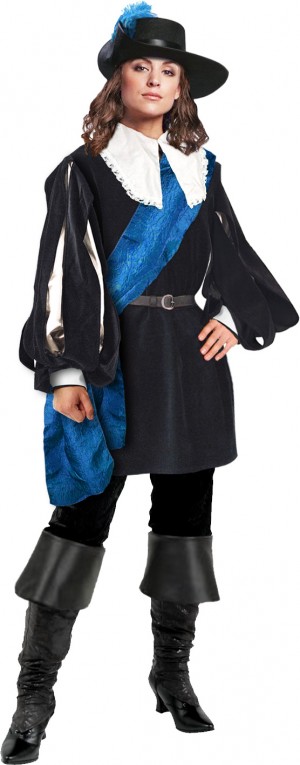 The items we suggest, from left to right:
The items we suggest, from left to right:
1. Black velvet cavalier shirt. The centerpiece of the costume is this gorgeous cavalier shirt with slashed sleeves. The body of the shirt is black velvet and the inner sleeves are a silvery white satin. It’s also available at the reenactment stores: By The Sword, Museum Replicas, and Pearson’s Renaissance Shoppe.
2. Crochet napkins. Why buy a fancy cavalier collar when you can use lace edge napkins? You might even have some in your pantry you can use. Just stuff them into the collar of your shirt and pin in place. You can fold and arrange them to get the effect you want. Use a similar procedure to make small cuffs; if you want big starched cuffs you’ll need to reinforce them with something, well, starchy. Try fusible interfacing.
3. Men’s black velvet pants or women’s black velour pants. The men’s pants are stretchy but not too snug; the women’s pants are tight fitting.
4. Royal blue taffeta sash. A modern chair sash is perfect for replicating the cross-body satin sash that 17th century kings were so fond of wearing. Tie it in a loose knot or floppy bow under one arm.
5. Musketeer hat with blue ostrich feathers. You can probably find both of these items locally, which might be best to make sure you get a decent hat that fits and feathers that are the color you want. Craft stores always have feathers, and cavalier/musketeer hats are usually available in party stores.
6. Cavalier boots or boot covers. Because Hollywood has made everybody think pirates wore cavalier boots (they didn’t), the easiest way to find what you need is to look for “pirate boots.” As if pirates were really sloshing around on deck wearing bucket tops meant for horse riding! Anyway, the costume stores usually stock both “pirate boots” as well as boot covers that you can just wear with an existing pair of shoes.
The gender issue: Christina was consistently described by her contemporaries as “mannish,” and she herself acknowledged that she had no liking or patience for the demure feminine behavior that was expected of her. This has led to three centuries of speculation about whether Christina was gay, bi, transgender, or intersexed. It’s worth bearing in mind, though, that what was considered mannish behavior in the 17th century wouldn’t raise an eyebrow today. Examples of Christina’s supposed masculinity included talking loudly, swearing, crossing her legs, putting her feet up, wearing pants, walking with a long stride, and riding a horse the normal way instead of sidesaddle. Wild.

